SAMSUNG LN55B650T1F User Manual

Contact SAMSUNG WORLDWIDE
If you have any questions or comments relating to Samsung products, please contact the SAMSUNG customer care center.
Comment contacter Samsung dans le monde
Si vous avez des suggestions ou des questions concernant les produits Samsung, veuillez contacter le Service Consommateurs Samsung.
Country |
Customer Care Center |
Web Site |
Address |
|||||||||||||||||||||||||||||||||||||
|
|
|
|
Samsung Electronics Canada Inc., Customer |
||||||||||||||||||||||||||||||||||||
|
|
|
|
Service 55 Standish Court Mississauga, |
||||||||||||||||||||||||||||||||||||
CANADA |
1-800-SAMSUNG(726-7864) |
www.samsung.com/ca |
Ontario L5R 4B2 Canada |
|||||||||||||||||||||||||||||||||||||
|
|
|
|
|
|
|
|
|
|
|
|
|
|
|
|
|
|
|
|
|
|
|
|
|
|
|
|
|
|
|
|
|
|
|
|
|||||
Samsung Electronique Canada Inc., Service |
||||||||||||||||||||||||||||||||||||||||
|
|
|
|
|||||||||||||||||||||||||||||||||||||
|
|
|
|
à la Clientèle 55 Standish Court Mississauga, |
||||||||||||||||||||||||||||||||||||
|
|
|
|
Ontario L5R 4B2 Canada |
||||||||||||||||||||||||||||||||||||
|
|
|
|
Samsung Electronics America, Inc. |
||||||||||||||||||||||||||||||||||||
U.S.A |
1-800-SAMSUNG(726-7864) |
www.samsung.com/us |
105 Challenger Road |
|||||||||||||||||||||||||||||||||||||
|
|
|
|
Ridgefield Park, NJ 07660-0511 |
||||||||||||||||||||||||||||||||||||
|
|
|
|
|
|
|
|
|
|
|
|
|
|
|
|
|
|
|
|
|
|
|
|
|
|
|
|
|
|
|
|
|
|
|
|
|
|
|
|
|
|
|
|
|
|
|
|
|
|
|
|
|
|
|
|
|
|
|
|
|
|
|
|
|
|
|
|
|
|
|
|
|
|
|
|
|
|
|
|
|
|
|
|
|
|
|
|
|
|
|
|
|
|
|
|
|
|
|
|
|
|
|
|
|
|
|
|
|
|
|
|
|
|
|
|
|
|
|
|
|
|
|
LCD TV
user manual
imagine the possibilities
Thank you for purchasing this Samsung product. To receive more complete service, please register your product at
www.samsung.com/register
Model |
|
Serial No. |
BN68-02089E-00

Important Warranty Information Regarding Television Format Viewing
N See the warranty card for more information on warranty terms.
Wide screen format LCD Displays (16:9, the aspect ratio of the screen width to height) are primarily designed to view wide screen format full-motion video. The images displayed on them should primarily be in the wide screen 16:9 ratio format, or expanded to fill the screen if your model offers this feature and the images are constantly moving. Displaying stationary graphics and images on screen, such as the dark sidebars on nonexpanded standard format television video and programming, should be limited to no more than 5% of the total television viewing per week.
Additionally, viewing other stationary images and text such as stock market reports, video game displays, station logos, web sites or computer graphics and patterns, should be limited as described above for all televisions. Displaying stationary images that exceed the above guidelines can cause uneven aging of LCD Displays that leave subtle, but permanent burned-in ghost images in the LCD picture. To avoid this, vary the programming and images, and primarily display full screen moving images, not stationary patterns or dark bars.
On LCD models that offer picture sizing features, use these controls to view different formats as a full screen picture.
Be careful in the selection and duration of television formats used for viewing. Uneven LCD aging as a result of format selection and use, as well as burned-in images, are not covered by your Samsung limited warranty.
●U.S.A Only
The product unit accompanying this user manual is licensed under certain intellectual property rights of certain third parties. In particular, this product is licensed under the following US patents: 5,991,715, 5,740,317, 4,972,484, 5,214,678, 5,323,396, 5,539,829, 5,606,618, 5,530,655, 5,777,992, 6,289,308, 5,610,985, 5,481,643, 5,544,247, 5,960,037, 6,023,490, 5,878,080, and under US Published Patent Application No. 2001-44713-A1.
This license is limited to private non-commercial use by end-user consumers for licensed contents. No rights are granted for commercial use. The license does not cover any product unit other than this product unit and the license does not extend to any unlicensed product unit or process conforming to ISO/IEC 11172-3 or ISO/IEC 13818-3 used or sold in combination with this product unit. The license only covers the use of this product unit to encode and/or decode audio files conforming to the
ISO/IEC 11172-3 or ISO/IEC 13818-3. No rights are granted under this license for product features or functions that do not conform to the ISO/IEC 11172-3 or ISO/IEC 13818-3.
●Other countries
The product unit accompanying this user manual is licensed under certain intellectual property rights of certain third parties. This license is limited to private non-commercial use by end-user consumers for licensed contents. No rights are granted for commercial use. The license does not cover any product unit other than this product unit and the license does not extend to any unlicensed product unit or process conforming to ISO/IEC 11172-3 or ISO/IEC 13818-3 used or sold in combination with this product unit. The license only covers the use of this product unit to encode and/or decode audio files conforming to the
ISO/IEC 11172-3 or ISO/IEC 13818-3. No rights are granted under this license for product features or functions that do not conform to the ISO/IEC 11172-3 or ISO/IEC 13818-3.
●SAMSUNG ELECTRONICS NORTH AMERICAN LIMITED WARRANTY STATEMENT
Subject to the requirements, conditions, exclusions and limitations of the original Limited Warranty supplied with Samsung Electronics (SAMSUNG) products, and the requirements, conditions, exclusions and limitations contained herein, SAMSUNG will additionally provide Warranty Repair Service in the United States on SAMSUNG products purchased in Canada, and
in Canada on SAMSUNG products purchased in the United States, for the warranty period originally specified, and to the
Original Purchaser only.
The above described warranty repairs must be performed by a SAMSUNG Authorized Service Center. Along with this Statement, the Original Limited Warranty Statement and a dated Bill of Sale as Proof of Purchase must be presented to the Service Center. Transportation to and from the Service Center is the responsibility of the purchaser.
Conditions covered are limited only to manufacturing defects in material or workmanship, and only those encountered in normal use of the product.
Excluded, but not limited to, are any originally specified provisions for, in-home or on-site services, minimum or maximum repair times, exchanges or replacements, accessories, options, upgrades, or consumables.
For the location of a SAMSUNG Authorized Service Center, please call toll-free:
N In the United States : 1-800-SAMSUNG (1-800-726-7864) N In Canada : 1-800-SAMSUNG
Precautions When Displaying a Still Image
A still image may cause permanent damage to the TV screen
●Do not display a still image on the LCD panel for more than 2 hours as it can cause screen image retention. This image retention is also known as screen burn. To avoid such image retention, reduce the degree of brightness and contrast of the screen when displaying a still image.
●Watching the LCD TV in 4:3 format for a long period of time may leave traces of borders displayed on the left, right and center of the screen caused by the difference of light emission on the screen. Playing a DVD or a game console may cause a similar effect to the screen. Damages caused by the above effect are not covered by the Warranty.
●Displaying still images from Video games and PC for longer than a certain period of time may produce partial after-images. To prevent this effect, reduce the ‘brightness’ and ‘contrast’ when displaying still images.
© 2009 Samsung Electronics Co., Ltd. All rights reserved.
[650-NA]BN68-02097A-Eng.indb 1 |
|
|
2009-03-30 2:49:26 |
|
|
||
|
|
|
|
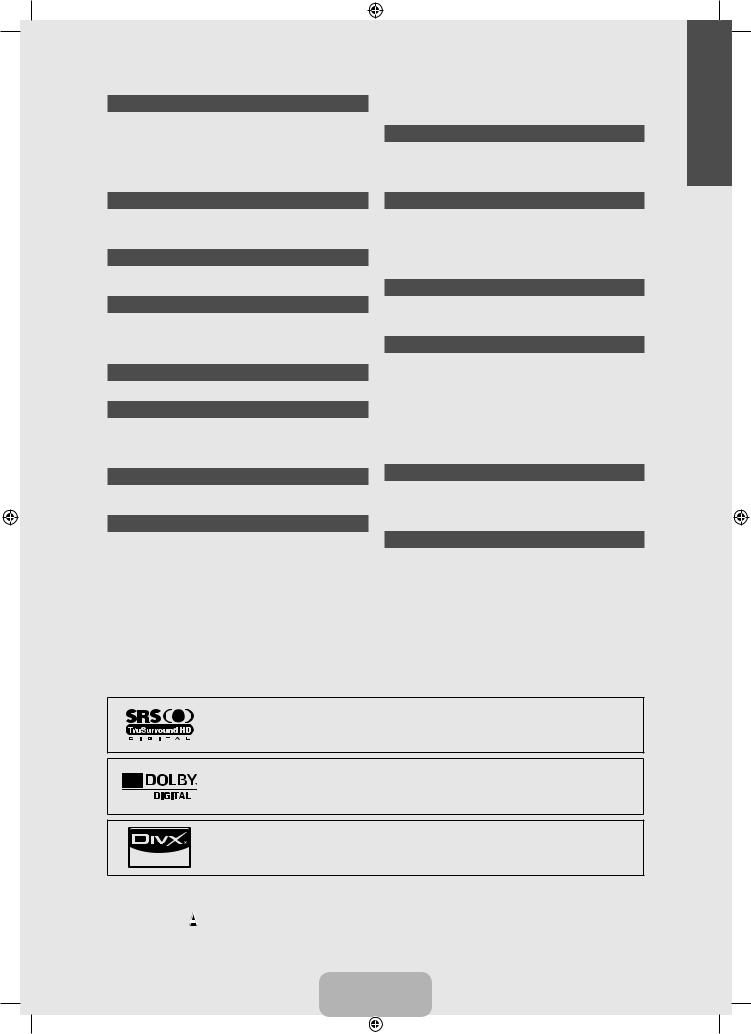
Contents |
|
Setting up Your TV |
|
■List of Features.................................................................................. |
2 |
■Accessories........................................................................................ |
2 |
■Viewing the Control Panel.................................................................. |
3 |
■Viewing the Remote Control............................................................... |
4 |
■Installing Batteries in the Remote Control.......................................... |
5 |
■Viewing the menus............................................................................. |
5 |
■Plug & Play Feature........................................................................... |
7 |
Connections |
|
■Connecting VHF and UHF Antennas................................................. |
8 |
■Connecting Cable TV......................................................................... |
9 |
■Viewing the Connection Panel......................................................... |
10 |
CHANNEL |
|
■Channel Menu.................................................................................. |
13 |
■Managing Channels......................................................................... |
14 |
PICTURE |
|
■Configuring the Picture Menu........................................................... |
16 |
■Viewing Picture-in-Picture................................................................ |
20 |
■Using Your TV as a Computer (PC) Display..................................... |
21 |
■Setting up the TV with your PC........................................................ |
22 |
SOUND |
|
■Configuring the Sound Menu........................................................... |
23 |
SETUP |
|
■Configuring the Setup Menu............................................................ |
25 |
■Setting the Time............................................................................... |
28 |
■Network Connection......................................................................... |
30 |
■Setting the Network.......................................................................... |
33 |
INPUT / SUPPORT |
|
■Input Menu....................................................................................... |
36 |
■Support Menu................................................................................... |
36 |
Media Play (USB & DLNA) |
|
■Connecting a USB Device................................................................ |
39 |
■Media Play Function......................................................................... |
40 |
■Sorting the Photo List....................................................................... |
42 |
■Photo List Option Menu.................................................................... |
43 |
■Viewing a Photo or Slide Show........................................................ |
44 |
■Slide Show Option Menu.................................................................. |
45 |
■Sorting the Music List....................................................................... |
47 |
■Music List Option Menu.................................................................... |
48 |
■Playing Music................................................................................... |
49 |
■Music Play option Menu................................................................... |
50 |
■Sorting the Movie List....................................................................... |
50 |
■Movie List Option Menu................................................................... |
51 |
■Playing a Movie File......................................................................... |
51 |
License
■Movie Play Option Menu.................................................................. |
54 |
■Using the Setup Menu...................................................................... |
55 |
Media Play-DLNA |
|
■Setting the DLNA Network............................................................... |
56 |
■Installing the DLNA Application........................................................ |
57 |
■Using the DLNA Application............................................................. |
58 |
■Using the DLNA Function................................................................. |
60 |
ANYNET+ |
|
■Connecting Anynet+ Devices........................................................... |
61 |
■Setting Up Anynet+.......................................................................... |
62 |
■Switching between Anynet+ Devices............................................... |
62 |
■Recording......................................................................................... |
63 |
■Listening through a Receiver (Home Theater)................................. |
63 |
■Troubleshooting for Anynet+............................................................ |
64 |
Content Library |
|
■Using the Content Library................................................................ |
65 |
■Using the TV Memory Contents....................................................... |
66 |
■Using the Content Management...................................................... |
67 |
Internet@TV |
|
■Getting Started with Internet@TV.................................................... |
68 |
■Editing Snippets in the Dock............................................................ |
71 |
■Using the Profile Widget................................................................... |
71 |
■Using the Yahoo!® Widget Gallery................................................... |
73 |
■Using the Yahoo!® Weather Widget................................................. |
74 |
■Using the Yahoo!® News Widget..................................................... |
74 |
■Using the Yahoo!® Flickr Widget...................................................... |
75 |
■Using the Yahoo!® Finance Widget................................................. |
76 |
■Troubleshooting for internet@TV..................................................... |
76 |
■Help Website.................................................................................... |
76 |
Home Network Center |
|
■Home Network Center...................................................................... |
77 |
■Setting Up the Home Network Center.............................................. |
78 |
■Using the Message Function............................................................ |
79 |
■Using the Media Function................................................................ |
80 |
RECOMMENDATIONS |
|
■Troubleshooting................................................................................ |
81 |
■Installing the Stand........................................................................... |
82 |
■Disconnecting the Stand.................................................................. |
82 |
■Assembling the Cables.................................................................... |
83 |
■Wall Mount Kit Specifications (VESA).............................................. |
83 |
■Anti-Theft Kensington Lock.............................................................. |
84 |
■Securing the Installation Space........................................................ |
84 |
■Securing the TV to a Wall or Cabinet............................................... |
85 |
■Specifications................................................................................... |
86 |
■Dimensions...................................................................................... |
88 |
TruSurround HD, SRS and 
 symbol are trademarks of SRS Labs, Inc. TruSurround HD technology is incorporated under license from SRS Labs, Inc.
symbol are trademarks of SRS Labs, Inc. TruSurround HD technology is incorporated under license from SRS Labs, Inc.
Manufactured under license from Dolby Laboratories. Dolby and the double-D symbol are trademarks of Dolby Laboratories.
DivX® Certified to play DivX® video, including premium content.
Symbol
|
N |
O |
T |
Press |
Note |
One-Touch Button |
TOOL Button |
English -
English
[650-NA]BN68-02097A-Eng.indb 1 |
|
|
2009-03-30 2:49:26 |
|
|
||
|
|
|
|

Setting up Your TV
To use your TV, you first have to set it up to suit your environment.
NFigures and illustrations in this User Manual are provided for reference only and may differ from actual product appearance. Product design and specifications may be changed without notice in order to enhance product performance.
¦List of Features
●Adjustable picture settings that can be stored in the TV’s memory.
●Automatic timer to turn the TV on and off.
●A special sleep timer.
●Excellent Digital Interface & Networking : With a built-in HD digital tuner, nonsubscription HD broadcasts can be viewed with no Cable Box/Satellite receiver (Set-Top Box) needed.
●HDMI/DVI connection of your PC to this TV.
●Excellent Picture Quality
●SRS TruSurround HD provides a virtual surround system.
●Media Play: Allows you to play music files, pictures, and movies saved on a USB or DLNA device.
●Internet@TV: You can use various internet services and view useful information and entertaining content.
●Home Network Center: Allows you to configure a mobile message server or a DLNA media render.
¦Accessories
|
|
|
|
|
|
|
|
|
|
Remote Control (BN59-00854A) |
Program CD |
Cover-Bottom |
||
(LN40B650: BN63-05286A) |
||||
& Batteries (AAA x 2) |
(BN59-00726D) |
(LN46B650: BN63-05287A) |
||
|
|
|
|
(LN55B650: BN63-05478A) |
|
|
|
|
|
|
|
|
|
|
(M4xL16) |
|
|
|
|
|
|
|
|
|
|
|
|
|
|
|
|
Warranty Card / |
Stand Screw (X4) |
Power Cord |
|||
|
(6002-001294) |
|||||
|
|
Safety Guide |
(3903-000144) |
|||
|
|
LN40B650, LN46B650 |
||||
|
|
|
|
|
|
|
|
|
|
|
|
|
|
|
|
|
|
|
|
|
|
|
|
|
|
|
|
|
|
|
|
|
|
|
 (M4xL16)
(M4xL16)
TV-Holder & Screw (X1) |
Cleaning Cloth |
Holder-Wire Cable |
|
(BN96-10788A) |
(BN61-05596A) |
||
(BN63-01798B) |
|||
(Depending on the model) |
(Depending on the model) |
||
|
|||
|
|
|
N Please make sure the following items are included with your LCD TV. If any items are missing, contact your dealer.
N The items color and shape may vary depending on the model.
English -
[650-NA]BN68-02097A-Eng.indb 2 |
|
|
2009-03-30 2:49:28 |
|
|
||
|
|
|
|
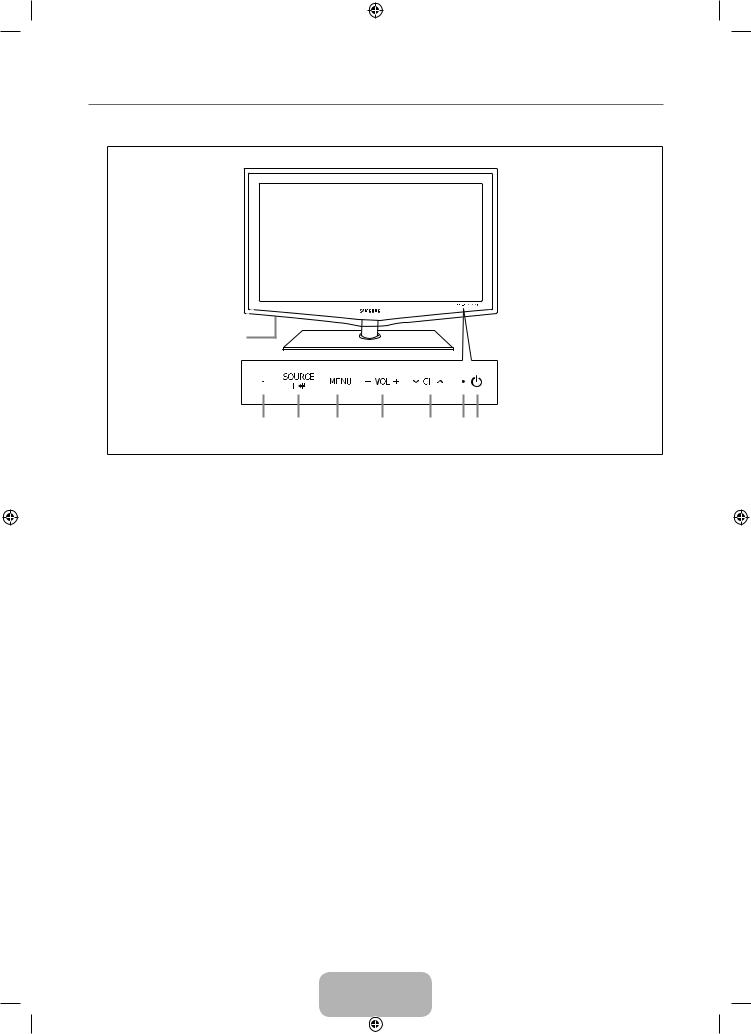
¦ Viewing the Control Panel
N The product color and shape may vary depending on the model.
N The front panel buttons can be activated by touching them with your finger.
 8
8
7 6 5 4 3 21
1P(POWER): Press to turn the TV on and off.
2POWER INDICATOR: Blinks and turns off when the power is on and lights up in stand-by mode.
3z: Press to change channels. In the on-screen menu, use the zbuttons as you would use the ▼ and ▲ buttons on the remote control.
4y: Press to increase or decrease the volume. In the on-screen menu, use the ybuttons as you would use the
◄ and ► buttons on the remote control.
5MENU: Press to see an on-screen menu of your TV’s features.
6SOURCE E: Toggles between all the available input sources. In the on-screen menu, use this button as you use the
ENTEREbutton on the remote control.
7REMOTE CONTROL SENSOR: Aim the remote control towards this spot on the TV.
8SPEAKERS
English -
[650-NA]BN68-02097A-Eng.indb 3 |
|
|
2009-03-30 2:49:28 |
|
|
||
|
|
|
|
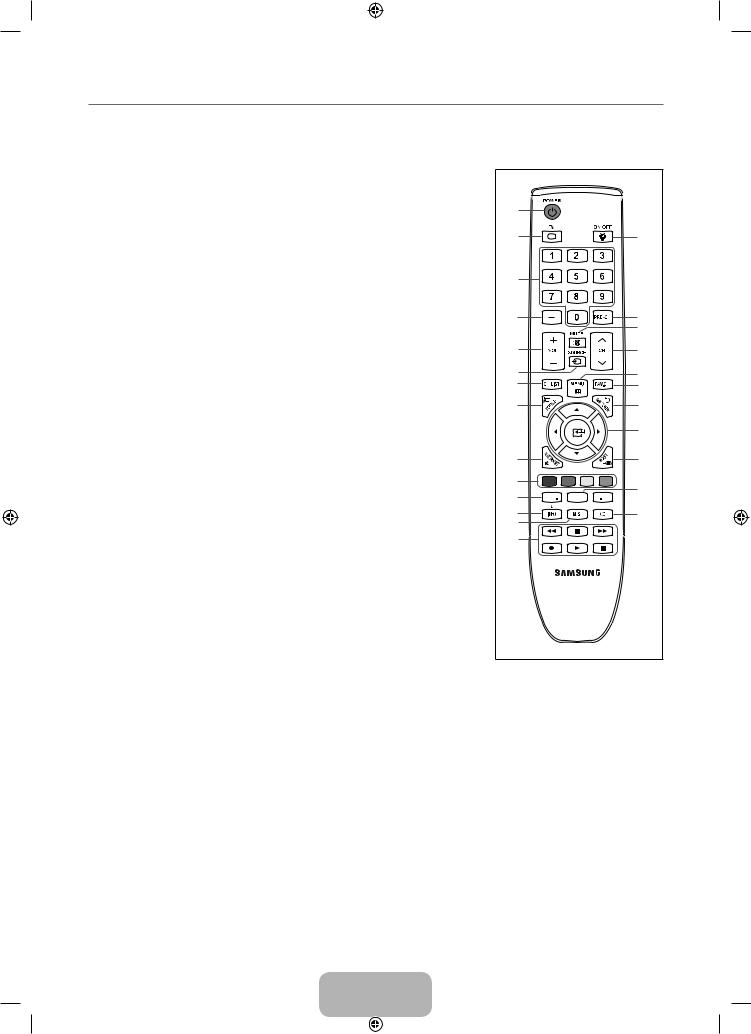
¦ Viewing the Remote Control
N You can use the remote control up to a distance of about 23 feet from the TV. N The performance of the remote control may be affected by bright light.
N The product color and shape may vary depending on the model.
1POWER : Turns the TV on and off.
2TV : Selects the TV mode directly.
3NUMERIC BUTTONS : Press to change the channel.
4_: Press to select additional channels (digital) being broadcast by the same station.
For example, to select channel
‘54-3’, press ‘54’, then press ‘_’ and ‘3’.
5y: Press to increase or decrease the volume.
6SOURCE: Press to display and select the available video sources.
7CH LIST : Used to display Channel Lists on the screen.
8TOOLS : Use to quickly select frequently used functions.
9INTERNET@ : Press to use various internet services to view useful information and entertaining content.
0COLOR BUTTONS : Use these buttons in the Channel list,
Internet@TV, Media Play menu, etc.
!MEDIA.P: Allows you to play music files, pictures, and movies.
@INFO: Press to display information on the TV screen.
#MTS: Press to choose stereo, mono or Separate Audio Program (SAP broadcast).
$ Use these buttons in the Media Play and Anynet+ modes. (∏:
This remote can be used to control recording on Samsung recorders with the Anynet+ feature)
%ON/OFF @: Pressing the
ON/OFF @light button toggles between on and off. When the remote control is on, and a button is pressed on the remote control, the remote control buttons will be lit for a moment. (Using the remote control with the ON/OFF
@light button set to On will reduce the battery usage time.)
^PRE-CH : Enables you to return to the previous channel you were watching.
&MUTE M: Press to temporarily cut off the sound.
*z: Press to change channels.
( MENU : Displays the main onscreen menu.
) FAV.CH : Press to switch to your favorite channels.
aRETURN : Returns to the previous menu
bUP▲ / DOWN▼ / LEFT◄ / RIGHT► / ENTERE: Use to select on-screen menu items and change menu values.
cEXIT : Press to exit the menu.
dCONTENT: This function enables you to view the Content Library.
eP.SIZE: Picture size selection.
fCC: Controls the caption decoder.
1 |
|
2 |
% |
3 |
|
4 |
^ |
|
& |
5 |
* |
6 |
( |
|
|
7 |
) |
8 |
a |
|
b |
9 |
c |
0
d
!






 e
e
@ |
f |
# |
|
$ |
|
English -
[650-NA]BN68-02097A-Eng.indb 4 |
|
|
2009-03-30 2:49:28 |
|
|
||
|
|
|
|
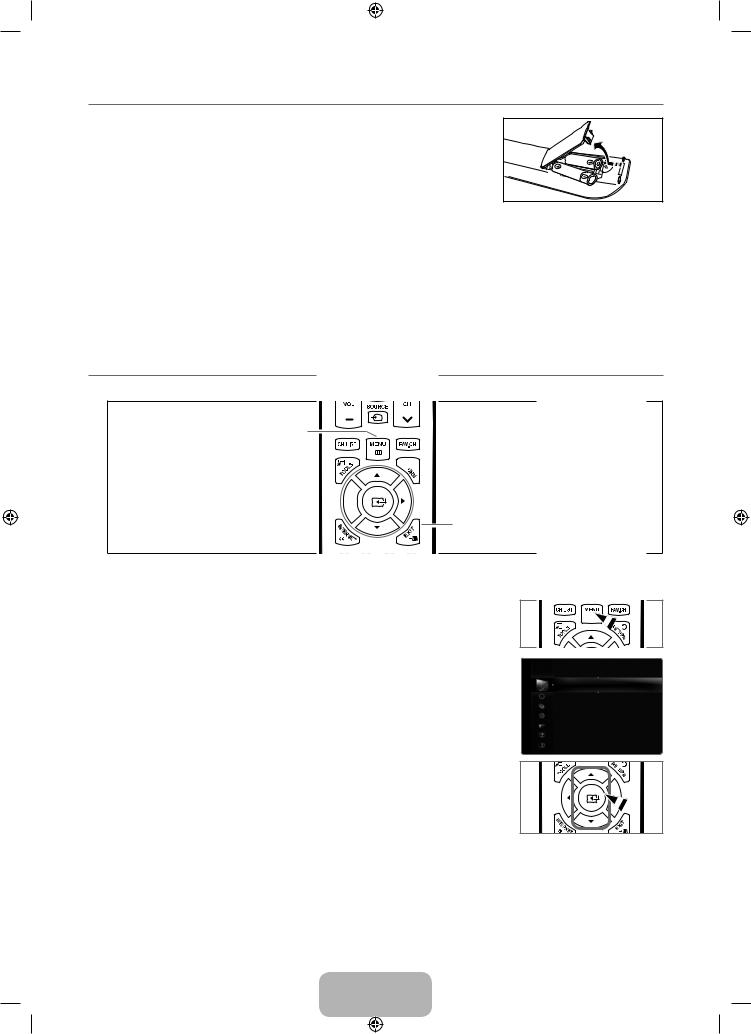
¦ Installing Batteries in the Remote Control
1. Lift the cover at the back of the remote control upward as shown in the figure.
2. Install two AAA size batteries.
N Make sure to match the ‘+’ and ‘–’ ends of the batteries with the diagram inside the compartment.
3. Replace the cover.
NRemove the batteries and store them in a cool, dry place if you won’t be using the remote control for a long time. (Assuming typical TV usage, the batteries should last for about one year.)
NIf the remote control doesn’t work, check the following:
Is the TV power on?
Are the plus and minus ends of the batteries reversed?
Are the batteries drained?
Is there a power outage or is the power cord unplugged?
Is there a special fluorescent light or neon sign nearby?
¦Viewing the menus
Before using the TV, follow the steps below to learn how to navigate the menu in order to select and adjust different functions.
MENU Button
Display the main on-screen menu.
ENTERE/ DIRECTION Button  Move the cursor and select an item. Select
Move the cursor and select an item. Select 
the currently selected item. Confirm the setting.
Operation the OSD (On Screen Display)
The access step may differ depending on the selected menu.
1.Press the MENU button.


 RETURN Button
RETURN Button
Return to the previous menu.
EXIT
Exit the on-screen menu.
2.The main menu appears on the screen. The menu’s left side has icons : Picture, Sound,
Channel, Setup, Input, Application, Support.
3.Press the ▲ or ▼ button to select one of the icons.
Picture
Mode |
: Standard |
|
Backlight |
: 7 |
|
Contrast |
: 95 |
|
Brightness |
: 45 |
|
Sharpness |
: 50 |
|
Color |
: 50 |
|
Tint (G/R) |
: G50/R50 |
|
Advanced Settings |
|
|
English -
[650-NA]BN68-02097A-Eng.indb 5 |
2009-03-30 2:49:29 |
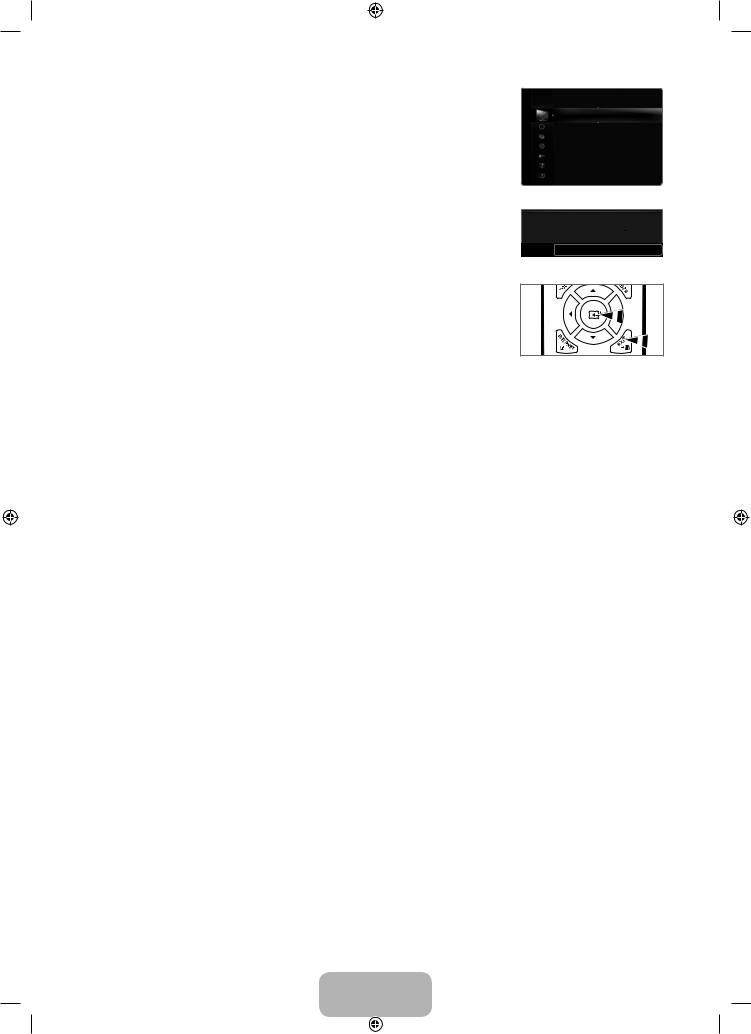
4.Then press the ENTEREbutton to access the icon’s sub-menu.
5.Press the ▲ or ▼ button to select the icon’s submenu.
6.Press the ◄ or ► button to decrease or increase the value of a particular item. The adjustment OSD may differ depending on the selected menu.
7.Press the ENTEREbutton to complete the configuration. Press the EXIT button to exit.
English -
Picture
Mode |
: Standard |
|
Backlight |
: 7 |
|
Contrast |
: 95 |
|
Brightness |
: 45 |
|
Sharpness |
: 50 |
|
Color |
: 50 |
|
Tint (G/R) |
: G50/R50 |
|
Advanced Settings |
|
|
Picture Options |
|
|
▲
Backlight 

 7
7
▼
UMove LAdjust EEnter RReturn
 Help icon
Help icon
[650-NA]BN68-02097A-Eng.indb 6 |
|
|
2009-03-30 2:49:29 |
|
|
||
|
|
|
|

¦ Plug & Play Feature
When the TV is initially powered on, basic settings proceed automatically and subsequently.
1.Press the POWERPbutton on the remote control.
N You can also use the POWERPbutton on the TV.
N The message Select Language of the OSD. is displayed.
2.Press the ENTEREbutton. Press the ▲ or ▼ button to select the language, then press the ENTEREbutton. The message Select ‘Home Use’ when installing this TV in your home. is displayed.
3.Press the ◄ or ► button to select Store Demo or Home Use, then press the ENTERE button. The message Select the Antenna source to memorize. is displayed.
N We recommend setting the TV to Home Use mode for the best picture in your home environment.
N Store Demo mode is only intended for use in retail environments.
Plug & Play
SelectLanguage of theOSD.
Language |
: English |
|
EEnter
NIf the unit is accidentally set to Store Demo mode and you want to return to Home Use (Standard): Press the volume button on the TV. When the volume OSD is displayed, press and hold the MENU button on the TV for 5 seconds.
4.Press the ▲ or ▼ button to memorize the channels of the selected connection. Press the ENTEREbutton to select Start.
NAir: Air antenna signal. / Cable: Cable antenna signal. / Auto: Air and Cable antenna signals.
NIn Cable mode, you can select the correct signal source among STD, HRC, and IRC by pressing the ▲, ▼, ◄ or ► button, then press the ENTEREbutton. If you have Digital cable, select the cable system signal source for both Analog and Digital. Contact your local cable company to identify the type of cable system that exists in your particular area.
5.Press the ENTEREbutton to select Start. The TV will begin memorizing all of the available channels.
NTo stop the search before it has finished, press the ENTEREbutton with Stop selected.
NAfter all the available channels are stored, it starts to remove scrambled channels. The Auto program menu then reappears. Press the ENTEREbutton when channel memorization is complete. The message Set the Clock Mode. is displayed.
6.Press the ENTEREbutton. Press the ▲ or ▼ button to select Auto, then Press the ENTEREbutton. The message Set to daylight saving time. is displayed. If you select Manual, Set current date and time. is displayed.
7.Press the ▲ or ▼ button to select Off, On or Auto, then press the ENTEREbutton.
8.Press the ▲ or ▼ button to highlight the time zone for your local area. Press the ENTEREbutton. If you have received a digital signal, the time will be set automatically. If not, refer to the ‘Setting the Time’ instructions to set the clock.
(see page 28)
9.The description for the connection method providing the best HD screen quality is displayed. Check the description and press the ENTEREbutton.
10.Press the ◄ or ► button to select See Product Guide or Watch TV. Press the ENTEREbutton.
See Product Guide: You are moved to the Product Guide where you can view the introduction to the main functions of your new HDTV.
Watch TV: You can watch the memorized channels.
If you want to reset this feature...
1.Press the MENU button to display the menu. Press the ▲ or ▼ button to select Setup, then press the ENTEREbutton.
2.Press the ENTEREbutton again to select Plug & Play.
N The Plug & Play feature is only available in the TV mode.
Setup
Plug &Play |
|
Language |
: English |
Time |
|
Game Mode |
: Off |
BD Wise |
: On |
Network Type |
: Cable |
Network Setup |
|
V-Chip |
|
English -
[650-NA]BN68-02097A-Eng.indb 7 |
|
|
2009-03-30 2:49:29 |
|
|
||
|
|
|
|
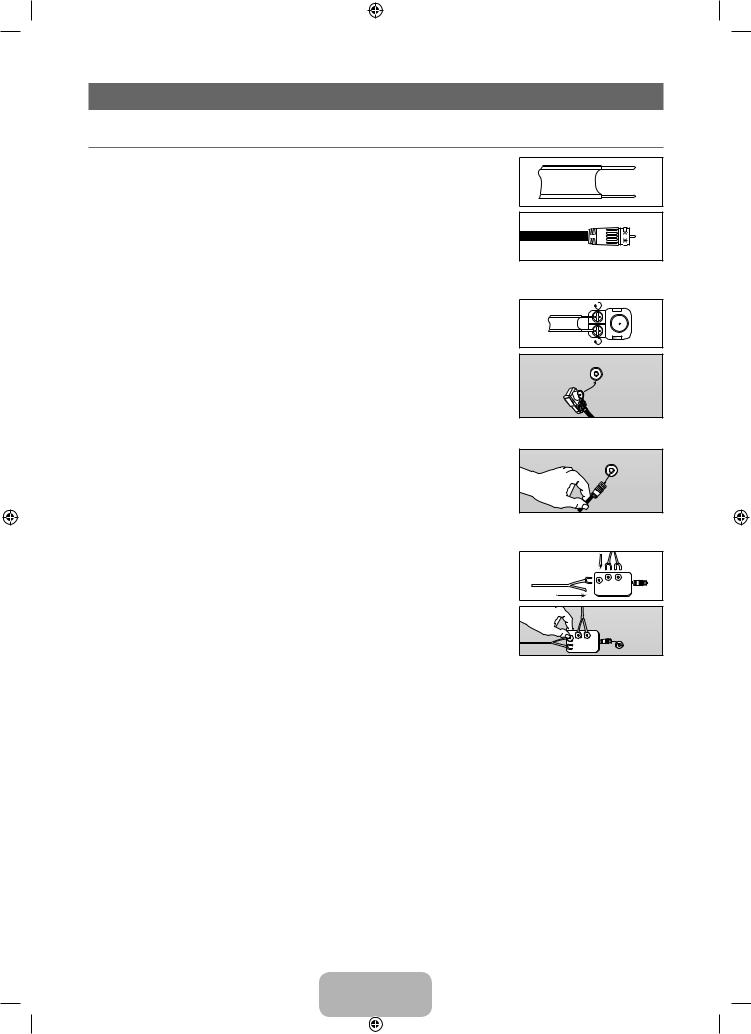
Connections
¦ Connecting VHF and UHF Antennas
If your antenna has a set of leads that look like the diagram to the right, see ‘Antennas with 300
Ω Flat Twin Leads’ below.
If your antenna has one lead that looks like the diagram to the right, see ‘Antennas with 75 Ω
Round Leads’.
If you have two antennas, see ‘Separate VHF and UHF Antennas’.
Antennas with 300 Ω Flat Twin Leads
If you are using an off-air antenna (such as a roof antenna or ‘rabbit ears’) that has 300Ω twin flat leads, follow the directions below.
1.Place the wires from the twin leads under the screws on a 300-75 Ω adapter (not supplied). Use a screwdriver to tighten the screws.
2.Plug the adaptor into the ANT IN terminal on the back of the TV.
Antennas with 75 Ω Round Leads
Plug the antenna lead into the ANT IN terminal on the back of the TV.
Separate VHF and UHF Antennas
If you have two separate antennas for your TV (one VHF and one UHF), you must combine the two antenna signals before connecting the antennas to the TV. This procedure requires an optional combiner-adaptor (available at most electronics shops).
1.Connect both antenna leads to the combiner.
2.Plug the combiner into the ANT IN terminal on the bottom of the rear panel.
ANT IN
ANT IN
UHF

 VHF
VHF
ANT IN
UHF
 VHF
VHF
English -
[650-NA]BN68-02097A-Eng.indb 8 |
|
|
2009-03-30 2:49:30 |
|
|
||
|
|
|
|
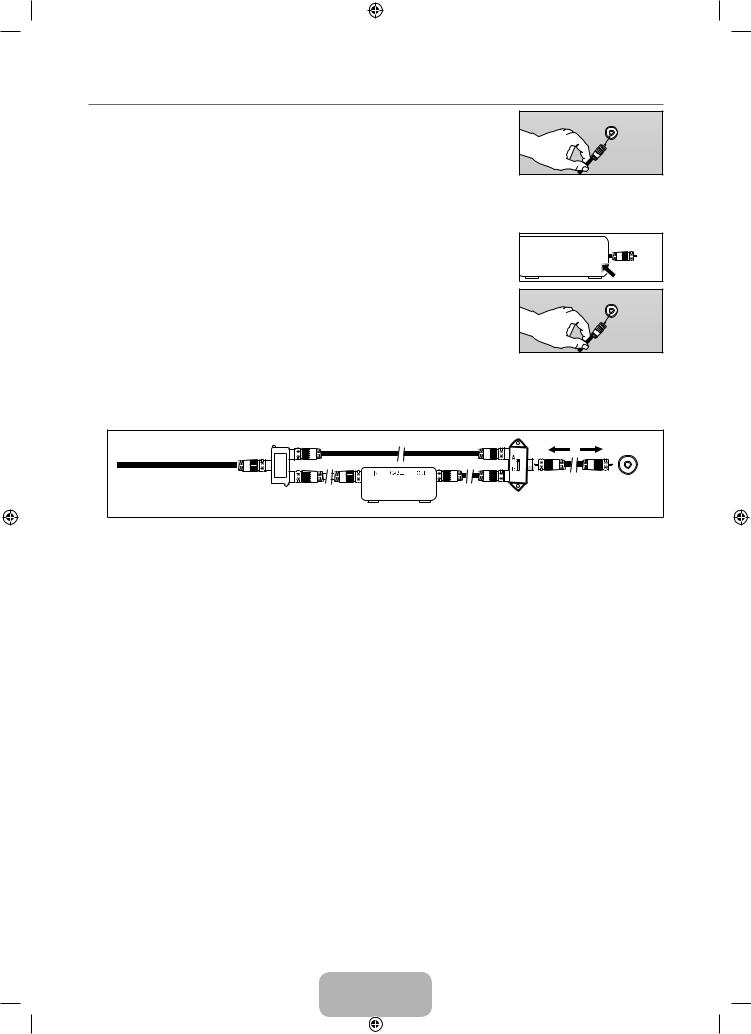
¦ Connecting Cable TV
To connect to a cable TV system, follow the instructions below.
Cable without a Cable Box
Plug the incoming cable into the ANT IN terminal on the back of the TV.
NBecause this TV is cable-ready, you do not need a cable box to view unscrambled cable channels.
ANT IN
Connecting to a Cable Box that Descrambles All Channels
1.Find the cable that is connected to the ANT OUT terminal on your cable box. N This terminal might be labeled ‘ANT OUT’, ‘VHF OUT’ or simply, ‘OUT’.
2.Connect the other end of this cable to the ANT IN terminal on the back of the TV.
ANT IN |
ANT OUT |
ANT IN
Connecting to a Cable Box that Descrambles Some Channels
If your cable box descrambles only some channels (such as premium channels), follow the instructions below. You will need a twoway splitter, an RF (A/B) switch and four lengths of RF cable. (These items are available at most electronics stores.)
ANT IN
Incoming cable
TV Rear
Splitter |
RF (A/B) Switch |
|
|
|
Cable Box |
1.Find and disconnect the cable that is connected to the ANT IN terminal on your cable box. N This terminal might be labeled ‘ANT IN’, ‘VHF IN’ or simply, ‘IN’.
2.Connect this cable to a two-way splitter.
3.Connect an RF cable between the OUTPUT terminal on the splitter and the IN terminal on the cable box.
4.Connect an RF cable between the ANT OUT terminal on the cable box and the B–IN terminal on the RF(A/B) switch.
5.Connect another cable between the other OUT terminal on the splitter and the A–IN terminal on the RF (A/B) switch.
6.Connect the last RF cable between the OUT terminal on the RF (A/B) switch and the ANT IN terminal on the rear of the TV.
After you have made this connection, set the A/B switch to the ‘A’ position for normal viewing. Set the A/B switch to the ‘B’ position to view scrambled channels. (When you set the A/B switch to ‘B’, you will need to tune your TV to the cable box’s output channel, which is usually channel 3 or 4.)
English -
[650-NA]BN68-02097A-Eng.indb 9 |
|
|
2009-03-30 2:49:30 |
|
|
||
|
|
|
|

¦ Viewing the Connection Panel
N The product color and shape may vary depending on the model.
Rear Panel
1
3 or
2 |
|
|
|
|
|
|
|
|
|
|
|
|
|
|
|
|
|
Cable Television |
|||||
|
|
|
|
|
|||
|
|
|
|
|
|
|
Network |
|
or |
|
|
|
|
|
|
|
|
|
|
|
|||
1POWER INPUT
Connects the supplied power cord.
N The location of the POWER INPUT may be different depending on its model.
2HDMI IN 1(DVI), 2, 3 / DVI AUDIO IN [R-AUDIO-L]
Connects to the HDMI jack of a device with an HDMI output.
N No sound connection is needed for an HDMI to HDMI connection.
N What is HDMI?
HDMI(High-Definition Multimedia Interface), is an interface that enables the transmission of digital audio and video signals using a single cable.
The difference between HDMI and DVI is that the HDMI device is smaller in size and has the HDCP (High Bandwidth Digital Copy Protection) coding feature installed.
NThe TV may not output sound and pictures may be displayed with abnormal color when DVD / Blu-ray player / Cable Box / Satellite receiver (Set-Top Box) supporting HDMI versions older than 1.3 are connected. When connecting an older HDMI cable and there is no sound, connect the HDMI cable to the HDMI IN 1(DVI) jack and the audio cables to the DVI AUDIO IN [R-AUDIO-L] jacks on the back of the TV. If this happens, contact the company that provided the DVD / Blu-ray player / Cable Box / Satellite receiver (Set-Top Box) to confirm the HDMI version, then request an upgrade.
N HDMI cables that are not 1.3 may cause annoying flicker or no screen display.
NUse the HDMI IN 1(DVI) jack for DVI connection to an external device. Use a DVI to HDMI cable or DVI-HDMI adapter (DVI to HDMI) for video connection and the DVI AUDIO IN [R-AUDIO-L] jacks for audio. When using an HDMI / DVI cable connection, you must use the HDMI IN 1(DVI) jack.
3ANT IN
Connects to an antenna or cable TV system.
English - 10
[650-NA]BN68-02097A-Eng.indb 10 |
|
|
2009-03-30 2:49:30 |
|
|
||
|
|
|
|
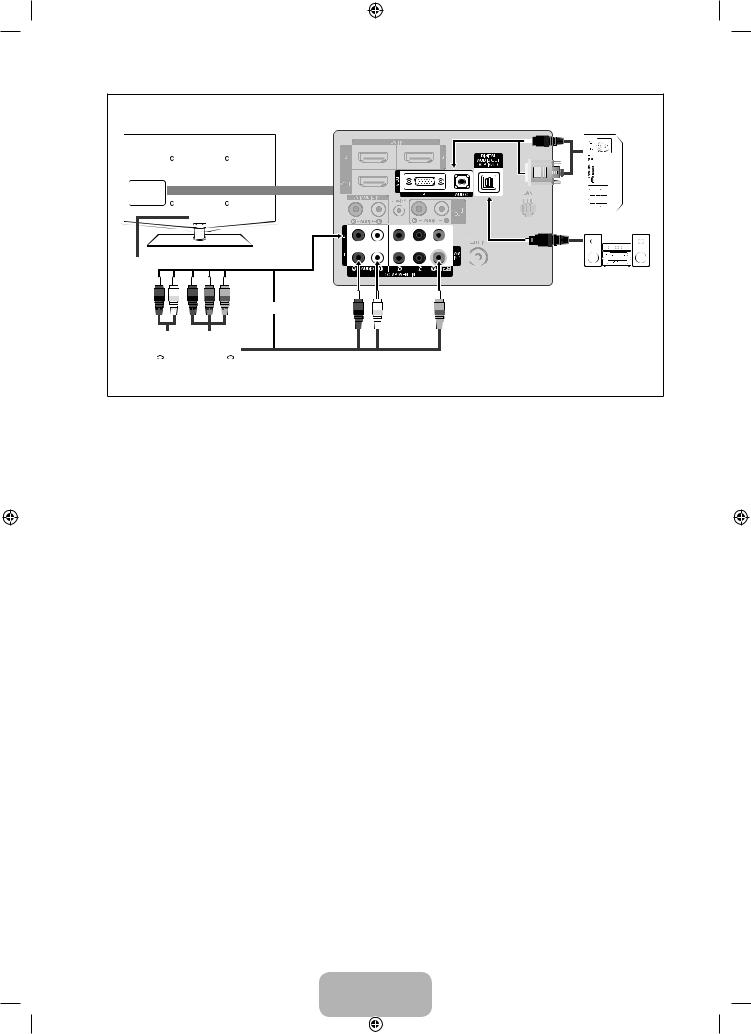
4
R W R B G
or
5 
6
7
R W Y
4KENSINGTON LOCK
The Kensington Lock (optional) is a device used to physically fix the system when used in a public place. If you want to use a locking device, contact the dealer where you purchased the TV.
N The location of the Kensington Lock may be different depending on its model.
5COMPONENT IN 1, 2 / AV IN 1
Connects Component video / audio.
The COMPONENT IN 1 jack is also used as the AV IN 1 jack.
N Connect the video cable to the COMPONENT IN 1 [Y/VIDEO] jack and the audio cable to the COMPONENT IN 1 [R- AUDIO-L] jacks.
N If you have a ‘mono’ (non-stereo) VCR, use a Y-connector (not supplied) to connect to the right and left audio input jacks of the TV. Alternatively, connect the cable to the ‘R’ jack. If your VCR is stereo, you must connect two cables.
N When connecting to AV IN 1, the color of the AV IN 1 [Y/VIDEO] jack (Green) does not match the color of the video cable (Yellow).
6PC IN [PC] / [AUDIO]
Connects to the video and audio output jacks on your PC.
N If your PC supports an HDMI connection, you can connect this to the HDMI IN 1(DVI), 2, 3 or 4 terminal.
N If your PC supports a DVI connection, you can connect this to the HDMI IN 1(DVI) / DVI AUDIO IN [R-AUDIO-L] terminal.
7DIGITAL AUDIO OUT (OPTICAL)
Connects to a Digital Audio component such as a Home theater receiver.
N When a Digital Audio System is connected to the DIGITAL AUDIO OUT (OPTICAL) jack: Decrease the volume of the TV and adjust the volume level with the system’s volume control.
N 5.1CH audio is possible when the TV is connected to an external device supporting 5.1CH.
N When the Home Theater receiver is set to On, you can hear sound output from the TV’s Optical jack. When the TV is displaying a DTV(air) signal, the TV will send out 5.1 channel sound to the Home theater receiver. When the source is a digital component such as a DVD / Blu-ray player / Cable Box / Satellite receiver (Set-Top Box) and is connected to the TV via HDMI, only 2 channel sound will be heard from the Home Theater receiver. If you want to hear 5.1 channel audio, connect the digital audio out jack on DVD / Blu-ray player / Cable Box / Satellite receiver (Set-Top Box) directly to an Amplifier or Home Theater, not the TV.
English - 11
[650-NA]BN68-02097A-Eng.indb 11 |
|
|
2009-03-30 2:49:31 |
|
|
||
|
|
|
|
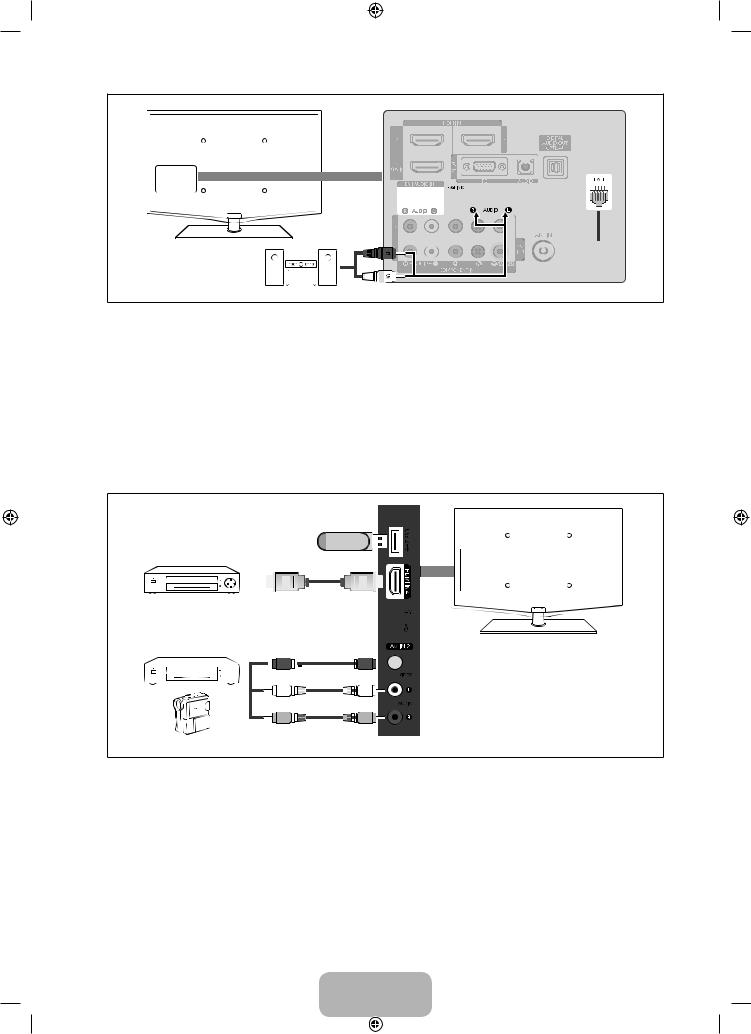
8




0
9 


8EX-LINK
Connector for service only.
9AUDIO OUT
Connects to the audio input jacks on your Amplifier/Home theater.
N When an audio amplifier is connected to the AUDIO OUT [R-AUDIO-L] jacks: Decrease the volume of the TV and adjust the volume level with the Amplifier’s volume control.
0LAN
Connect a LAN cable to this port to connect to the Network.
Side Panel
For devices frequently connected/disconnected from your TV, it is convenient to use the jacks on the side of your TV (e.g. Camcorder).
1 
2
1 



3
 R
R









 R
R






W |
|
|
|
|
|
|
|
|
W |
Y |
|
|
|
|
|
|
|
|
Y |
|
|
|
|
|
|
|
|||
|
|
|
|
|
|
|
|
|
|
1USB1(HDD) / USB2
Connector for software upgrades and Media Play, etc. You can connect to Samsung’s network wirelessly using the ‘Samsung
Wireless LAN Adapter’ (Sold separately).
N For USB HDD, use the USB1(HDD) port.
2HDMI IN 4
Connect to the HDMI jack of a device with HDMI output.
3AV IN 2 [VIDEO] / [R-AUDIO-L]
Video and audio inputs for external devices, such as a camcorder or VCR.
English - 12
[650-NA]BN68-02097A-Eng.indb 12 |
|
|
2009-03-30 2:49:31 |
|
|
||
|
|
|
|

CHANNEL
You can configure various settings for your TV channels with features such asAuto Program, Favorite Channels, and Signal
Strength.
¦ Channel Menu
Antenna → Air / Cable
Before your television can begin memorizing the available channels, you must specify the type of signal source that is connected to the TV (i.e. an Air or a Cable system).
TPress the TOOLS button to display the Tools menu. You can also set the Antenna by selecting Tools → Switch to Cable (or Switch to Air).
Auto Program
Channel
Antenna : Air
Auto Program
ClearScrambledChannel
Channel List
FineTune
■Air: Air antenna signal. / Cable: Cable antenna signal. / Auto: Air and Cable antenna signals
N When selecting the Cable TV system: Selects the cable system. STD, HRC and IRC identify various types of cable TV systems. Contact your local cable company to identify the type of cable system that exists in your particular area. At this point the signal source has been selected.
N After all the available channels are stored, it starts to remove scrambled channels (Removing scrambled channel). The Auto program menu then reappears.
N If you want to stop Auto Programming, press the ENTEREbutton. The Stop Auto Program? message will be displayed. Select Yes by pressing the ◄ or ► button, then press the ENTEREbutton.
Clear Scrambled Channel (digital channels only)
This function is used to filter out scrambled channels after Auto Program is completed. This process may take up to 20~30 minutes.
N To stop searching scrambled channels: Press the ENTEREbutton to select Stop. Press the ◄ button to select Yes, then press the ENTEREbutton.
N This function is only available in Cable mode.
Channel List
For detailed procedures on using the Channel List, refer to the ‘Managing Channels’ instructions. (see pages 14~15) O You can select these options by simply pressing the CH LIST button on the remote control.
Fine Tune (analog channels only)
Use fine tuning to manually adjust a particular channel for optimal reception.
N If you do not store the fine-tuned channel in memory, adjustments are not saved. N ‘*’ will appear next to the name of fine-tuned channels.
N To reset the fine tuning setting, press the ▼ button to select Reset, then press the ENTEREbutton.
English - 13
[650-NA]BN68-02097A-Eng.indb 13 |
|
|
2009-03-30 2:49:31 |
|
|
||
|
|
|
|
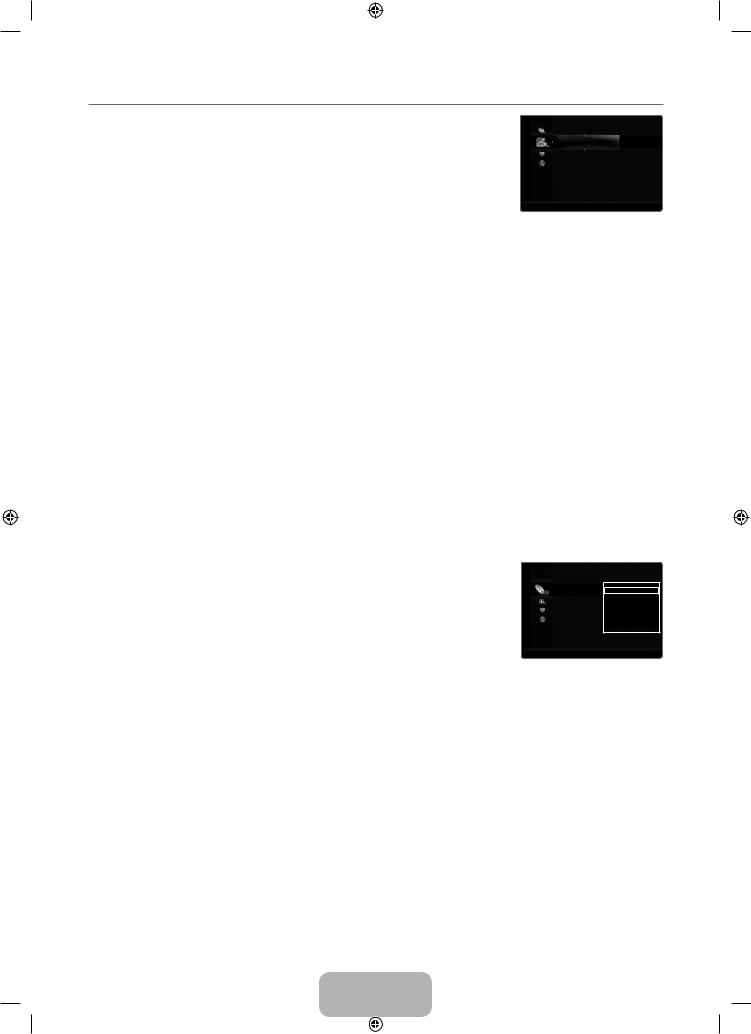
¦ Managing Channels
Using this menu, you can add / delete or set favorite channels and use the program guide for digital broadcasts.
■All Channels
Shows all currently available channels.
■Added Channels
Shows all added channels.
AddedChannels |
2 |
Air |
|
4 |
|
Air |
|
|||
|
4-2 |
* TV#8 |
|
||||
|
8 |
|
Air |
|
|||
|
13 |
Air |
|
||||
|
|
13-1 * TV#3 |
Alice’s Adventuresin Wonderland |
||||
Air |
|
Antenna |
|
Zoom |
|
Select |
TTools |
|
|
|
|||||
■Favorite
Shows all favorite channels.
O To select the favorite channels you have set up, press the FAV.CH button on the remote control.
■Programmed
Shows all current reserved programs.
N Select a channel in the All Channels, Added Channels or Favorite screen by pressing the ▲ / ▼ buttons, and pressing the
ENTEREbutton. Then you can watch the selected channel. N Using the color buttons with the Channel List
Red (Antenna): Switches to Air or Cable.
Green (Zoom): Enlarges or shrinks a channel number.
Yellow (Select): Selects multiple channel lists. You can perform the add/delete or add to Favorite/delete from Favorite function for multiple channels at the same time. Select the required channels and press the yellow button to set all the selected channels at the same time. The cmark appears to the left of the selected channels.
TOOLS (Tools): Displays the Add (or Delete), Add to Favorite (or Delete from Favorite), Timer Viewing, Channel Name Edit, Select All (or Deselect All) and Auto Program menus (The Options menus may differ depending on the situation.)
N Channel Status Display Icons
c : A channel selected by pressing the yellow button.
( : A program currently being broadcast. * : A channel set as a Favorite.
) : A reserved program.
Channel List Option Menu (in All Channels / Added Channels / Favorite)
N Press the TOOLS button to use the option menu.
NOption menu items may differ depending on the channel status.
■Add / Delete
You can delete or add a channel to display the channels you want.
NAll deleted channels will be shown on the All Channels menu.
NA gray-colored channel indicates the channel has been deleted.
NThe Add menu only appears for deleted channels.
NYou can also delete a channel from the Added Channels or Favorite menu in the same manner.
ChannelsAll |
2 |
|
Air |
|
|
|
|||
|
|
|
|
|
|||||
|
4 |
|
Air |
|
|
|
|||
|
|
|
|
|
|||||
|
|
|
Delete |
|
|||||
|
4-2 |
* TV #8 |
|
Add toFavorite |
|
||||
|
|
Timer Viewing |
|
||||||
|
8 |
|
Air |
|
|||||
|
|
|
Channel Name Ed |
||||||
|
13 |
|
Air |
|
|||||
|
|
|
Select All |
|
|||||
|
|
13-1 * TV #3 |
Alice’s |
Auto Program |
|
||||
|
|
|
|
|
|
|
|
|
|
Air |
|
Antenna |
|
Zoom |
|
Select TTools |
|||
|
|
|
|||||||
English - 14
[650-NA]BN68-02097A-Eng.indb 14 |
|
|
2009-03-30 2:49:32 |
|
|
||
|
|
|
|
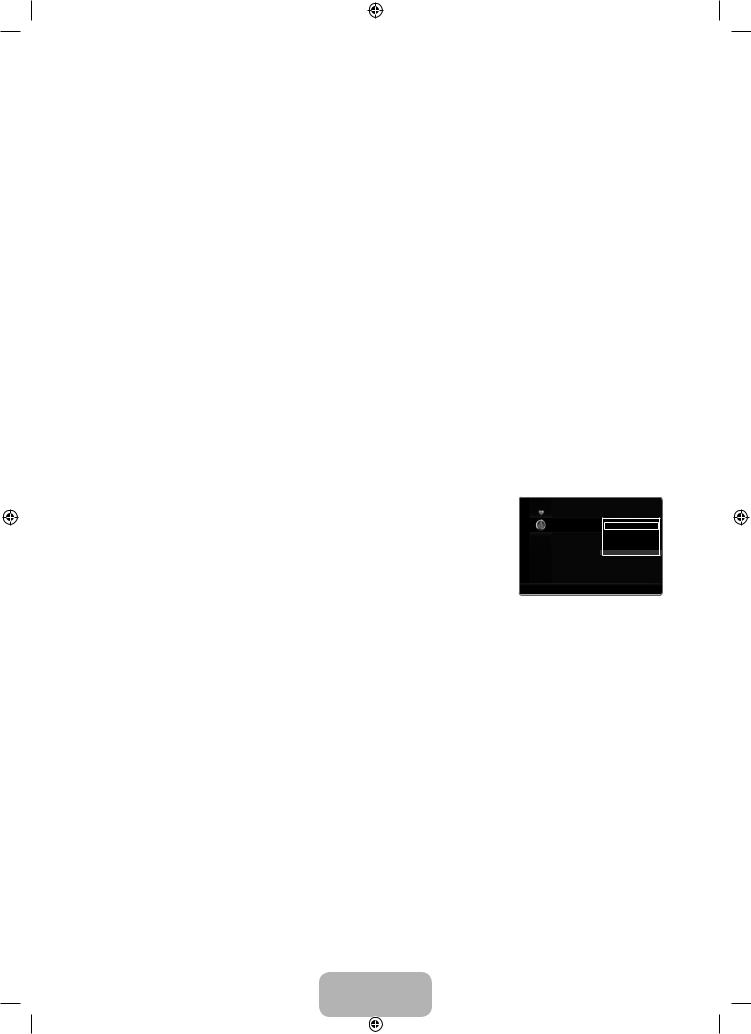
■Add to Favorite / Delete from Favorite
You can set channels you watch frequently as Favorite.
TPress the TOOLS button to display the Tools menu. You can also set the add to (or delete from) Favorites by selecting Tools
→ Add to Favorite (or Delete from Favorite).
NThe ‘*’ symbol will be displayed and the channel will be set as a favorite.
NAll favorite channels will be shown on Favorite menu.
■Timer Viewing
If you reserve a program you want to watch, the channel is automatically switched to the reserved channel in the Channel List; even when you are watching another channel. To reserve a program, set the current time first.
NOnly memorized channels can be reserved.
NYou can set the channel, day, month, year, hour and minute directly by pressing the number buttons on the remote control.
NReserving a program will be shown in the Programmed menu.
NDigital Program Guide and Viewing Reservation
When a digital channel is selected, and you press the ► button, the Program Guide for the channel appears. You can reserve a program according to the procedures described above.
■Channel Name Edit (analog channels only)
Channels can labeled so that their call letters appear whenever the channel is selected.
NThe names of digital broadcasting channels are automatically assigned and cannot be labeled.
■Select All / Deselect All
● Select All: You can select all the channels in the channel list.
● Deselect All: You can deselect all the selected channels.
NYou can only select Deselect All when there is a selected channel.
■Auto Program
NFor detailed procedures on using the Auto Program, refer to the ‘Channel Menu’ instructions. (see page 13)
Channel List Option Menu (in Programmed)
You can view, modify or delete a reservation.
N Press the TOOLS button to use the option menu.
■Change Info
Select to change a viewing reservation.
■Cancel Schedules
Select to cancel a viewing reservation.
■Information
Select to view a viewing reservation.
(You can also change the reservation information.)
■Select All
Select all reserved programs.
Programmed |
1 / 1/ 2009 |
|
|
Cancel Schedules |
|||||
|
|
|
|
|
|||||
|
|
1:59 5 TV1 |
) |
|
|
||||
|
|
|
|
||||||
|
|
Change Info |
|
||||||
|
2:59 |
2 |
TV3 |
) |
|
|
|||
|
Information |
||||||||
|
3:59 |
2 |
TV3 |
) |
Select All |
|
|||
|
4:59 |
2 |
TV3 |
) |
M.Spillane’s mike |
||||
Air |
|
Antenna |
|
Zoom |
|
Select |
TTools EInformation |
||
|
|
|
|||||||
English - 15
[650-NA]BN68-02097A-Eng.indb 15 |
|
|
2009-03-30 2:49:32 |
|
|
||
|
|
|
|

PICTURE
You can configure various picture options such as the picture mode, aspect ratio, and color to suit your personal preferences.
¦ Configuring the Picture Menu
Mode
You can select the type of picture which best corresponds to your viewing requirements.
TPress the TOOLS button to display the Tools menu. You can also set the picture mode by selecting Tools → Picture Mode.
■Dynamic
Selects the picture for increased definition in a bright room.
■Standard
Selects the picture for the optimum display in a normal environment.
■Natural
Selects the picture for an optimum and eye-comfortable display.
NNatural is not available in PC mode.
■Movie
Selects the picture for viewing movies in a dark room.
Backlight / Contrast / Brightness / Sharpness / Color / Tint(G/R)
Your television has several setting options that allow you to control the picture quality.
●Backlight: Adjusts the brightness of LCD back light.
●Contrast: Adjusts the contrast level of the picture.
●Brightness: Adjusts the brightness level of the picture
●Sharpness: Adjusts the edge definition of the picture.
●Color: Adjusts color saturation of the picture.
●Tint(G/R): Adjusts the color tint of the picture.
Picture |
Mode |
: Standard |
|
|
|||
|
Backlight |
: 7 |
|
|
Contrast |
: 95 |
|
|
Brightness |
: 45 |
|
|
Sharpness |
: 50 |
|
|
Color |
: 50 |
|
|
Tint (G/R) |
: G50/R50 |
|
|
Advanced Settings |
|
|
▲
Backlight 

 7
7
▼
UMove LAdjust EEnter RReturn
NWhen you make changes to Backlight, Contrast, Brightness, Sharpness, Color or Tint(G/R) the OSD will be adjusted accordingly.
N In PC mode, you can only make changes to Backlight, Contrast and Brightness.
N Settings can be adjusted and stored for each external device you have connected to an input of the TV.
NThe energy consumed during use can be significantly reduced if the brightness level of the picture is lowered, which will reduce the overall running cost.
Advanced Settings
Samsung’s new TVs allow you to make even more precise picture settings than previous models.
N Advanced Settings is available in Standard or Movie mode.
NIn PC mode, you can only make changes to Dynamic Contrast, Gamma and White Balance from among the Advanced Settings items.
■Black Tone → Off / Dark / Darker / Darkest
You can select the black level on the screen to adjust the screen depth.
Advanced Settings
Black Tone |
: Off |
|
Dynamic Contrast |
: Medium |
|
Gamma |
: 0 |
|
Color Space |
: Native |
|
White Balance |
|
|
Flesh Tone |
: 0 |
|
Edge Enhancement |
: On |
|
|
UMove EEnter |
RReturn |
English - 16
[650-NA]BN68-02097A-Eng.indb 16 |
|
|
2009-03-30 2:49:32 |
|
|
||
|
|
|
|

■Dynamic Contrast → Off / Low / Medium / High
You can adjust the screen contrast so that the optimal contrast is provided.
■Gamma
You can adjust the primary color (red, green, blue) intensity.
■Color Space
Color space is a color matrix composed of red, green and blue colors. Select your favorite color space to experience the most natural color.
●Auto: Auto color space automatically adjusts to the most natural color tone based on program sources.
●Native: Native color space offers deep and rich color tone.
●Custom: Adjusts the color range to suit your preference.
N Changing the adjustment value will refresh the adjusted screen.
N Settings can be adjusted and stored for each external device you have connected to an input of the TV. For example, if you have a DVD player connected to HDMI 1 and it is currently selected, settings and adjustments will be saved for the DVD player.
Color: Red, Green, Blue, Yellow, Cyan or Magenta
N Color is available when Color Space is set to Custom.
N In Color, you can adjust the RGB values for the selected color.
N To reset the adjusted RGB value, select Reset.
Red: Adjusts the red saturation level of the selected color.
Green: Adjusts the green saturation level of the selected color.
Blue: Adjusts the blue saturation level of the selected color.
Reset: Resets the color space to the default values.
■White Balance
You can adjust the color temperature for more natural picture colors.
●R-Offset: Adjusts the red color darkness.
●G-Offset: Adjusts the green color darkness.
●B-Offset: Adjusts the blue color darkness.
●R-Gain: Adjusts the red color brightness.
●G-Gain: Adjusts the green color brightness.
●B-Gain: Adjusts the blue color brightness.
●Reset: The previously adjusted white balance will be reset to the factory defaults.
■Flesh Tone
You can emphasize the pink ‘flesh tone’ in the picture.
N Changing the adjustment value will refresh the adjusted screen.
■Edge Enhancement → Off / On
You can emphasize object boundaries in the picture.
■xvYCC → Off / On
Setting the xvYCC mode to on increases detail and color space when watching movies from an external device (ie. DVD player) connected to the HDMI or Component IN jacks.
N xvYCC is available when the picture mode is set to Movie, and the external input is set to HDMI or Component mode.
English - 17
[650-NA]BN68-02097A-Eng.indb 17 |
|
|
2009-03-30 2:49:32 |
|
|
||
|
|
|
|

Picture Options
NIn PC mode, you can only make changes to the Color Tone and Size from among the items in Picture Options.
■Color Tone → Cool / Normal / Warm1 / Warm2 / Warm3
NWarm1, Warm2 or Warm3 is only activated when the picture mode is Movie.
NSettings can be adjusted and stored for each external device you have connected to an input of the TV.
Picture Options
Color Tone |
: Normal |
|
Size |
: 16:9 |
|
Digital NR |
: Auto |
|
HDMI Black Level |
: Normal |
|
FilmMode |
: Off |
|
Blue Only Mode |
: Off |
|
Auto Motion Plus 120Hz |
: Standard |
|
UMove EEnter RReturn
■Size
Occasionally, you may want to change the size of the image on your screen. Your TV comes
with several screen size options, each designed to work best with specific types of video input. Your cable box/satellite receiver may have its own set of screen sizes as well. In general, though, you should view the TV in 16:9 mode as much as possible. O Alternately, you can press the P.SIZE button on the remote control repeatedly to change the picture size.
●16:9 : Sets the picture to 16:9 wide mode.
●Zoom1: Magnifies the size of the picture on the screen.
●Zoom2: Magnifies the size of the picture more than Zoom1.
●Wide Fit: Enlarges the aspect ratio of the picture to fit the entire screen.
●4:3 : Sets the picture to 4:3 normal mode.
●Screen Fit: Use the function to see the full image without any cutoff when HDMI (720p/1080i/1080p), Component
(1080i/1080p) or DTV (1080i) signals are input.
|
|
|
|
|
|
|
|
|
|
|
|
16:9 |
|
Zoom1 UMove |
Zoom2 UMove |
||||||
|
|
|
|
|
|
|
|
|
|
|
16:9 |
|
|
|
Zoom1 |
|
|
Zoom2 |
|||
|
|
|
|
|
|
|
|
|
|
|
|
|
|
|
|
|
|
|
|
|
|
Wide Fit UMove |
|
|
4:3 |
|
|
|
Screen Fit |
|
||
|
|
|
|
|
|
|
|
|
|
|
Wide Fit |
4:3 |
Screen Fit |
|
|
|
N When Double (Œ, À) mode has been set in PIP, the Picture Size cannot be set.
N Temporary image retention may occur when viewing a static image on the set for more than two hours.
NAfter selecting Zoom1, Zoom2 or Wide Fit: Press the ► button to Select Position, then press the ENTEREbutton. Press the ▲ or ▼ button to move the picture up and down. Then press the ENTEREbutton. Press the ► button to Select Size, then press the ENTEREbutton. Press the ▲ or ▼ button to magnify or reduce the picture size in the vertical direction. Then press the ENTEREbutton.
NAfter selecting Screen Fit in HDMI (1080i/1080p) or Component (1080i/1080p) mode, you made need to center the picture:
Press the ◄ or ► button to select Position, then press the ENTEREbutton. Press the ▲, ▼, ◄ or ► button to move the picture.
Reset: Press the ◄ or ► button to select Reset, then press the ENTEREbutton. You can initialize the setting.
N HD (High Definition): 16:9 - 1080i/1080p (1920x1080), 720p (1280x720)
N Settings can be adjusted and stored for each external device you have connected to an input of the TV.
Input Source |
Picture Size |
|
ATV, AV, Component (480i, 480p) |
16:9, Zoom1, Zoom2, 4:3 |
|
DTV(1080i), Component (1080i, 1080p), |
16:9, 4:3, Wide Fit, Screen Fit |
|
HDMI (720p, 1080i, 1080p) |
||
|
||
PC |
16:9, 4:3 |
English - 18
[650-NA]BN68-02097A-Eng.indb 18 |
|
|
2009-03-30 2:49:33 |
|
|
||
|
|
|
|

■Digital NR → Off / Low / Medium / High / Auto
If the broadcast signal received by your TV is weak, you can activate the Digital Noise Reduction feature to help reduce any static and ghosting that may appear on the screen.
N When the signal is weak, select one of the other options until the best picture is displayed.
■HDMI Black Level → Normal / Low
You can select the black level on the screen to adjust the screen depth.
N This function is active only when an external device is connected to the TV via HDMI. The HDMI Black Level function may not be compatible with all external devices.
■Film Mode → Off / Auto1 / Auto2
The TV can be set to automatically sense and process film signals from all sources and adjust the picture for optimum quality.
N Film Mode is supported in TV, Video, Component (480i / 1080i) and HDMI (480i / 1080i).
●Off: Turns the Film Mode function off.
●Auto1: Automatically adjusts the picture for the best quality when watching a film.
●Auto2: Automatically optimizes the video text on the screen (not including closed captions) when watching a film.
■Blue Only Mode → Off / On
This function is for AV device measurement experts. This function displays the blue signal only by removing the red and green signals from the video signal so as to provide a Blue Filter effect that is used to adjust the color and Tint of video equipment such as DVD players, Home Theaters, etc. Using this function, you can adjust the color and Tint to preferred values appropriate to the signal level of each video device using the Red / Green / Blue / Cyan / Magenta / Yellow color Bar Patterns, without using an additional Blue Filter.
N Blue Only Mode is available when the picture mode is set to Movie or Standard.
■Auto Motion Plus 120Hz → Off / Clear / Standard / Smooth / Custom / Demo
Removes drag from fast scenes with a lot of movement to provide a clearer picture.
N If you enable Auto Motion Plus 120Hz, noise may appear on the screen. If this occurs, set Auto Motion Plus 120Hz to Off.
●Off: Switches Auto Motion Plus 120Hz off.
●Clear: Sets Auto Motion Plus 120Hz to minimum.
●Standard: Sets Auto Motion Plus 120Hz to medium.
●Smooth: Sets Auto Motion Plus 120Hz to maximum.
●Custom: Adjusts the blur and judder reduction level to suit your preference.
Blur Reduction: Adjusts the blur reduction level from video sources.
Judder Reduction: Adjusts the judder reduction level from video sources when playing films.
Reset: Reset the custom settings.
●Demo: Displays the difference between Auto Motion Plus 120Hz on and off modes.
Picture Reset → Reset Picture Mode / Cancel
Resets all picture settings to the default values.
N Reset Picture Mode: Current picture values return to default settings.
English - 19
[650-NA]BN68-02097A-Eng.indb 19 |
|
|
2009-03-30 2:49:33 |
|
|
||
|
|
|
|

¦ Viewing Picture-in-Picture
You can use the PIP feature to simultaneously watch the TV tuner and one external video source. This product has one built-in tuner, which does not allow PIP to function in the same mode. Please see ‘PIP Settings’ below for details.
TPress the TOOLS button to display the Tools menu. You can also configure PIP related settings by selecting Tools → PIP.
NIf you select the PIP picture sound, refer to the ‘Configuring the Sound Menu’ instructions. (see page 24)
N PIP Settings
Main picture |
Sub picture |
Component 1, 2 |
|
HDMI1/DVI, HDMI2, HDMI3, HDMI4 |
TV |
PC |
|
Setup
Melody |
: Medium |
Energy Saving |
: Off |
PIP |
|
N While V-Chip or Internet@TV is in operation, the PIP function cannot be used.
N If you turn the TV off while watching in PIP mode and turn it on again, the PIP window will disappear.
NYou may notice that the picture in the PIP window becomes slightly unnatural when you use the main screen to view a game or karaoke.
PIP → On / Off
You can activate or deactivate the PIP function.
■Size → Õ/ Ã/ À/ Œ
You can select a size of the PIP-picture.
■Position → Ã/ –/ —/ œ
You can select a position of the PIP-picture.
N In Double (Œ, À) mode, Position cannot be selected.
■Air/Cable → Air / Cable
Select either Air or Cable as the input source for the sub-screen.
■Channel
You can select the channel for the sub-screen.
PIP
PIP |
:On |
|
Size |
:Õ |
|
Position |
:Ã |
|
Air/Cable |
:Air |
|
Channel |
:Air3 |
|
|
UMove |
EEnter RReturn |
English - 20
[650-NA]BN68-02097A-Eng.indb 20 |
|
|
2009-03-30 2:49:33 |
|
|
||
|
|
|
|

¦ Using Your TV as a Computer (PC) Display
Setting Up Your PC Software (Based on Windows XP)
The Windows display-settings for a typical computer are shown below. The actual screens on your PC will probably be different, depending upon your particular version of Windows and your particular video card. However, even if your actual screens look different, the same basic set-up information will apply in almost all cases. (If not, contact your computer manufacturer or Samsung Dealer.)
1.First, click on ‘Control Panel’ on the Windows start menu.
2.When the control panel window appears, click on ‘Appearance and Themes’ and a display dialog-box will appear.
3.When the control panel window appears, click on ‘Display’ and a display dialogbox will appear.
4.Navigate to the ‘Settings’ tab on the display dialog-box.
The correct size setting (resolution) - Optimum: 1920 X 1080 pixels
If a vertical-frequency option exists on your display settings dialog box, the correct value is ‘60’ or ‘60 Hz’. Otherwise, just click ‘OK’ and exit the dialog box.
Display Modes
If the signal from the system equals the standard signal mode, the screen is adjusted automatically. If the signal from the system doesn’t equal the standard signal mode, adjust the mode by referring to your videocard user guide; otherwise there may be no video. For the display modes listed below, the screen image has been optimized during manufacturing.
■D-Sub and HDMI/DVI Input
N When using an HDMI / DVI cable connection, you must use the HDMI IN 1(DVI) jack.
Mode |
Resolution |
Horizontal Frequency |
Vertical Frequency |
Pixel Clock Frequency |
Sync Polarity |
|
(KHz) |
(Hz) |
(MHz) |
(H / V) |
|||
|
|
|||||
IBM |
640 x 350 |
31.469 |
70.086 |
25.175 |
+/- |
|
720 x 400 |
31.469 |
70.087 |
28.322 |
-/+ |
||
MAC |
640 x 480 |
35.000 |
66.667 |
30.240 |
-/- |
|
832 x 624 |
49.726 |
74.551 |
57.284 |
-/- |
||
|
1152 x 870 |
68.681 |
75.062 |
100.000 |
-/- |
|
|
720 x 576 |
35.910 |
59.950 |
32.750 |
-/+ |
|
VESA CVT |
1152 x 864 |
53.783 |
59.959 |
81.750 |
-/+ |
|
1280 x 720 |
44.772 |
59.855 |
74.500 |
-/+ |
||
|
1280 x 720 |
56.456 |
74.777 |
95.750 |
-/+ |
|
|
1280 x 960 |
75.231 |
74.857 |
130.000 |
-/+ |
|
|
640 x 480 |
31.469 |
59.940 |
25.175 |
-/- |
|
|
640 x 480 |
37.861 |
72.809 |
31.500 |
-/- |
|
|
640 x 480 |
37.500 |
75.000 |
31.500 |
-/- |
|
|
800 x 600 |
37.879 |
60.317 |
40.000 |
+/+ |
|
|
800 x 600 |
48.077 |
72.188 |
50.000 |
+/+ |
|
|
800 x 600 |
46.875 |
75.000 |
49.500 |
+/+ |
|
|
1024 x 768 |
48.363 |
60.004 |
65.000 |
-/- |
|
|
1024 x 768 |
56.476 |
70.069 |
75.000 |
-/- |
|
VESA DMT |
1024 x 768 |
60.023 |
75.029 |
78.750 |
+/+ |
|
1152 x 864 |
67.500 |
75.000 |
108.000 |
+/+ |
||
|
1280 x 1024 |
63.981 |
60.020 |
108.000 |
+/+ |
|
|
1280 x 1024 |
79.976 |
75.025 |
135.000 |
+/+ |
|
|
1280 x 800 |
49.702 |
59.810 |
83.500 |
-/+ |
|
|
1280 x 800 |
62.795 |
74.934 |
106.500 |
-/+ |
|
|
1280 x 960 |
60.000 |
60.000 |
108.000 |
+/+ |
|
|
1360 x 768 |
47.712 |
60.015 |
85.500 |
+/+ |
|
|
1440 x 900 |
55.935 |
59.887 |
106.500 |
-/+ |
|
|
1440 x 900 |
70.635 |
74.984 |
136.750 |
-/+ |
|
|
1680 x 1050 |
65.290 |
59.954 |
146.250 |
-/+ |
|
VESA GTF |
1280 x 720 |
52.500 |
70.000 |
89.040 |
-/+ |
|
1280 x 1024 |
74.620 |
70.000 |
128.943 |
-/- |
||
VESA DMT / |
1920 x 1080p |
67.500 |
60.000 |
148.500 |
+/+ |
|
DTV CEA |
||||||
|
|
|
|
|
English - 21
[650-NA]BN68-02097A-Eng.indb 21 |
|
|
2009-03-30 2:49:33 |
|
|
||
|
|
|
|

¦ Setting up the TV with your PC
NPreset: Press the SOURCE button to select PC mode.
Auto Adjustment
Use the Auto Adjust function to have the TV automatically adjust the video signals it receives.
The function also automatically fine-tunes the settings and adjusts the frequency values and positions.
TPress the TOOLS button to display the Tools menu. You can also set the Auto Adjustment by selecting Tools → Auto Adjustment.
N This function does not work in DVI-Digital mode.
Screen
■Coarse / Fine
The purpose of picture quality adjustment is to remove or reduce picture noise. If the noise is not removed by Fine-tuning alone, then adjust the frequency as best as possible (Coarse) and
Fine-tune again. After the noise has been reduced, readjust the picture so that it is aligned on the center of screen.
■PC Position
Adjust the PC’s screen positioning if it does not fit the TV screen.
Press the ▲ or ▼ button to adjusting the Vertical-Position. Press the ◄ or ► button to adjust the Horizontal-Position.
■Image Reset
You can replace all image settings with the factory default values.
English - 22
|
Brightness |
: 45 |
|
Picture |
Sharpness |
: 50 |
|
Auto Adjustment |
|
||
|
Screen
AdvancedSettings
Picture Options
Picture Reset
Screen
Coarse |
|
|
|
|
50 |
|
|
|
|||
Fine |
|
|
0 |
||
|
|
||||
PC Position |
|
|
|
||
Image Reset |
|
|
|
||
|
|
UMove |
|
EEnter RReturn |
|
[650-NA]BN68-02097A-Eng.indb 22 |
|
|
2009-03-30 2:49:33 |
|
|
||
|
|
|
|

SOUND
You can configure the sound mode, volume, multi-track sound options, etc.
¦ Configuring the Sound Menu
Mode → Standard / Music / Movie / Clear Voice / Custom
TPress the TOOLS button to display the Tools menu. You can also set the sound mode by selecting Tools → Sound Mode.
●Standard: Selects the normal sound mode.
●Music: Emphasizes music over voices.
●Movie: Provides the best sound for movies.
●Clear Voice: Emphasizes voice over other sounds.
Sound
Mode |
:Custom |
|
Equalizer |
|
|
SRS TruSurround HD |
: Off |
|
PreferredLanguage |
: English |
|
Multi-Track Sound |
: Mono |
|
Auto Volume |
: Off |
|
SpeakerSelect |
: TV Speaker |
|
Sound Select |
: Main |
|
●Custom: Recalls your customized sound settings.
Equalizer
The sound settings can be adjusted to suit your personal preference.
●Mode: Selects the sound mode among the predefined settings.
●Balance L/R: Adjusts the balance between the right and left speaker.
●100Hz / 300Hz / 1KHz / 3KHz / 10KHz (Bandwidth Adjustment): To adjust the level of different bandwidth frequencies.
●Reset: Resets the equalizer settings to the default values.
SRS TruSurround HD → Off / On
SRS TruSurround HD is a patented SRS technology that solves the problem of playing 5.1 multichannel content over two speakers. TruSurround delivers a compelling, virtual surround sound experience through any two-speaker playback system, including internal television speakers. It is fully compatible with all multichannel formats.
TPress the TOOLS button to display the Tools menu. You can also set the SRS TruSurround HD by selecting Tools → SRS TS
HD.
Preferred Language (digital channels only)
Digital-TV broadcasts are capable of simultaneous transmission of many audio tracks (for example, simultaneous translations of the program into foreign languages).
NYou can listen in a language other than the Preferred Language by pressing the MTS button on the remote control.
N Preferred Language is available only in Digital TV mode.
N You can only select the language from among the actual languages being broadcast.
Multi-Track Sound (MTS) (analog channels only)
O Press the MTS button on the remote control repeatedly to select Mono, Stereo or SAP.
●Mono: Choose for channels that are broadcasting in mono or if you are having difficulty receiving a stereo signal.
●Stereo: Choose for channels that are broadcasting in stereo.
●SAP: Choose to listen to the Separate Audio Program, which is usually a foreign-language translation.
N Multi-Track Sound is available only in Analog TV mode.
N Depending on the particular program being broadcast, you can listen to Mono, Stereo or SAP.
English - 23
[650-NA]BN68-02097A-Eng.indb 23 |
|
|
2009-03-30 2:49:33 |
|
|
||
|
|
|
|

Auto Volume → Off / On
Each broadcasting station has its own signal conditions, and so it is not easy to adjust the volume every time the channel is changed. This feature lets you automatically adjust the volume of the desired channel by lowering the sound output when the modulation signal is high or by raising the sound output when the modulation signal is low.
Speaker Select
When you watch TV with it connecting to a Home theater, turn the TV speakers off so you can listen to sound from the Home theater’s (external) speakers.
●External Speaker: Used to listen to the sound of the External (Home Theater) Speakers.
●TV Speaker: Used to listen to the sound of the TV Speakers.
NThe volume and MUTE buttons do not operate when the Speaker Select is set to External Speaker. Please set the volume on your Home theater.
N If you select External Speaker in the Speaker Select menu, the sound settings will be limited
|
TV’s Internal Speakers |
Audio Out (Optical, L/R Out) to Sound System |
|
RF / AV / Component / PC / HDMI |
RF / AV / Component / PC / HDMI |
TV Speaker |
Sound Output |
Sound Output |
External Speaker |
Mute |
Sound Output |
Video No Signal |
Mute |
Mute |
Sound Select → Main / Sub
When the PIP feature is activated, you can listen to the sound of the sub (PIP) picture. N You can select this option when PIP is set to On.
TPress the TOOLS button to display the Tools menu. You can also set the sound of the sub picture by selecting Tools → PIP → Sound Select.
Sound Reset → Reset All / Reset Sound Mode / Cancel
You can restore the Sound settings to the factory defaults.
N Reset Sound Mode: Current sound values return to default settings.
Sound Reset
Select the sound reset options.
ResetAll |
ResetSoundMode |
Cancel |
|
|
|
|
LMove |
EEnter RReturn |
|
|
|
English - 24
[650-NA]BN68-02097A-Eng.indb 24 |
|
|
2009-03-30 2:49:33 |
|
|
||
|
|
|
|

SETUP
You can set up additional functions.
¦ Configuring the Setup Menu
Language
You can set the menu language.
Time
For detailed procedures on setting up options, refer to the ‘Setting the Time’ instructions.
(see pages 28~29)
Game Mode → Off / On
Setup
Plug& Play |
|
|
Language |
: English |
|
Time |
|
|
Game Mode |
: Off |
|
BD Wise |
: On |
|
Network Type |
: Cable |
|
Network Setup |
|
|
V-Chip |
|
|
Caption |
|
|
When connecting to a game console such as PlayStation™ or Xbox™, you can enjoy a more realistic gaming experience by selecting game menu.
NRestrictions on game mode (Caution)
To disconnect the game console and connect another external device, set Game Mode to Off in the setup menu.
If you display the TV menu in Game Mode, the screen shakes slightly.
N Game Mode is not available in regular TV and PC mode.
N While PIP is in operation, the Game Mode function cannot be used.
NIf the picture is poor when external device is connected to TV, check if Game Mode is On. Set Game Mode to Off and connect external devices.
NIf Game Mode is On:
Picture mode is automatically changed to Standard and cannot be changed.
Sound mode is automatically changed to Custom and cannot be changed. Adjust the sound using the equalizer.
The Reset Sound function is activated. Selecting the Reset function after setting the equalizer resets the equalizer settings to the factory defaults.
BD Wise → Off / On
Provides the optimal picture quality for SAMSUNG DVD, Blu-ray and Home Theater products which support BD Wise. You can enjoy a richer picture when using them connected to this Samsung TV.
NConnect SAMSUNG products that have BD Wise using an HDMI cable.
NWhen the BD Wise set to On, the picture mode is automatically changed to the optimal resolution.
NBD Wise is available in HDMI mode.
Network Type / Network Setup
For detailed procedures on setting up options, refer to the ‘Setting the Network’ instructions. (see pages 30~35)
V-Chip
The V-Chip feature automatically locks out programs that are deemed inappropriate for children. The user must enter a PIN
(personal ID number) before any of the V-Chip restrictions are set up or changed.
NV-Chip function is not available in HDMI, Component or PC mode.
N The default PIN number of a new TV set is ‘0-0-0-0’
NAllow all: Press to unlock all TV ratings. / Block all: Press to lock all TV ratings.
■Change PIN
The Change PIN screen will appear. Choose any 4 digits for your PIN and enter them. As soon as the 4 digits are entered, the Confirm New PIN screen appears. Re-enter the same 4 digits. When the Confirm screen disappears, your PIN has been memorized.
NIf you forget the PIN, press the remote-control buttons in the following sequence, which resets the pin to 0-0-0-0 : POWER
(off) → MUTE → 8 → 2 → 4 → POWER (on).
English - 25
[650-NA]BN68-02097A-Eng.indb 25 |
|
|
2009-03-30 2:49:33 |
|
|
||
|
|
|
|

■V-Chip Lock → Off / On
You can block rated TV Programs.
■TV Parental Guidelines
You can block TV programs depending on their rating. This function allows you to control what your children are watching.
●TV-Y: Young children / TV-Y7: Children 7 and over / TV-G: General audience / TV-PG: Parental guidance / TV-14: Viewers 14 and over / TV-MA: Mature audience
●ALL: Lock all TV ratings. / FV: Fantasy violence / V: Violence / S: Sexual situation / L:
Adult Language / D: Sexually Suggestive Dialog
NThe V-Chip will automatically block certain categories that are more restrictive. For example, if you block TV-Y category, then TV-Y7 will automatically be blocked. Similarly, if you block the TV-G category, then all the categories in the young adult group will be blocked (TV-G, TV-PG, TV-14 and TV-MA). The sub-ratings (D, L, S, V) work together similarly.
TV Parental Guidelines
|
|
ALL |
FV |
V |
S |
|
L |
D |
Allow All |
|
TV-Y |
|
|
|
|
|
|
|
Block All |
|
TV-Y7 |
|
|
|
|
|
|
|
|
|
|
|
|
|
|
|
|
|
|
|
TV-G |
|
|
|
|
|
|
|
|
|
TV-PG |
|
|
|
|
|
|
|
|
|
TV-14 |
|
|
|
|
|
|
|
|
|
TV-MA |
|
|
|
|
|
|
|
|
|
|
|
|
nMove |
EEnter RReturn |
||||
NThe V-chip will automatically block certain categories that are ‘More restrictive’. For example, if you block L sub-rating in TVPG, then the L sub-ratings in TV-14 and TV-MA will automatically be blocked.
■MPAA Rating
You can block movies depending on their MPAA rating. The Motion Picture Association of America(MPAA) has implemented a rating system that provides parents or guardians with advance information on which films are appropriate for children.
●G: General audience (no restrictions).
●PG: Parental guidance suggested.
●PG-13: Parents strongly cautioned.
●R: Restricted. Children under 17 should be accompanied by an adult.
●NC-17: No children under age 17.
●X: Adults only.
●NR: Not rated.
|
MPAA Rating |
|
|||
|
|
|
|
|
|
G |
|
|
|
|
|
|
|
|
|
|
|
PG |
|
|
|
|
Allow All |
|
|
|
|
||
PG-13 |
|
|
|
|
Block All |
|
|
|
|
||
R |
|
|
|
|
|
|
|
|
|
|
|
NC-17 |
|
|
|
|
|
|
|
|
|
|
|
X |
|
|
|
|
|
|
|
|
|
|
|
NR |
|
|
|
|
|
|
nMove EEnter |
RReturn |
|||
NThe V-Chip will automatically block any category that is ‘More restrictive’. For example, if you block the PG-13 category, then R, NC-17 and X will automatically be blocked also.
■Canadian English
● C: Programming intended for children under age 8.
● C8+: Programming generally considered acceptable for children 8 years and over to watch on their own.
● G: General programming, suitable for all audiences. ● PG: Parental Guidance.
● 14+: Programming contains themes or content which may not be suitable for viewers under the age of 14. ● 18+: Adult programming.
NThe V-Chip will automatically block any category that is ‘More restrictive’. For example, if you block G category, then PG, 14+ and 18+ will automatically be blocked also.
■Canadian French
●G: General
●8 ans+: Programming generally considered acceptable for children 8 years and over to watch on their own.
●13 ans+: Programming may not be suitable for children under the age of 13.
●16 ans+: Programming is not suitable for children under the age of 16.
●18 ans+: Programming restricted to adults.
NThe V-Chip will automatically block any category that is ‘More restrictive’. For example, if you block 8 ans+ category, then 13 ans+, 16 ans+ and 18 ans+ will automatically be blocked also.
English - 26
[650-NA]BN68-02097A-Eng.indb 26 |
|
|
2009-03-30 2:49:34 |
|
|
||
|
|
|
|

■Downloadable U.S. Rating
Parental restriction information can be used while watching DTV channels
N If information is not downloaded from the broadcasting station, the Downloadable U.S. rating menu is deactivated.
N Parental restriction information is automatically downloaded while watching DTV channels. It may take several seconds.
N The Downloadable U.S. rating menu is available for use after information is downloaded from the broadcasting station. However, depending on the information from the broadcasting station, it may not be available for use.
N Parental restriction levels differ depending on the broadcasting station. The default menu name and Downloadable US rating changes depending on the downloaded information.
|
|
|
The number of all rating information |
|
|
|
||||
|
|
|
|
|
|
|||||
Rating title |
The number of current rating information |
|
||||||||
|
|
|
|
|
|
|
|
|
|
|
|
|
|
Downloadable U.S. Rating |
|
|
|||||
|
|
|
|
|
|
|
|
|
|
|
|
Humor Level |
|
► |
|
1/2 |
|
||||
|
|
|
|
|
|
|
Allow All |
|||
|
DH |
|
|
|
|
|||||
|
MH |
|
|
|
|
Block All |
||||
|
H |
|
|
|
|
|
|
|
|
|
|
VH |
|
|
|
|
|
|
|
|
|
|
EH |
|
|
|
|
|
|
|
|
|
|
|
|
|
|
|
|
|
|
|
|
|
|
|
nMove |
EEnter |
RReturn |
|||||
NEven if you set the On-screen display to your desired language, the Downloadable U.S. Rating menu will appear in English only.
N The rating will automatically block certain categories that are more restrictive.
NThe rating titles (For example: Humor Level..etc) and TV ratings (For example: DH, MH, H..etc) may differ depending on the broadcasting station.
How to Reset the TV after the V-Chip Blocks a Channel (Emergency Escape)
If the TV is tuned to a restricted channel, the V-Chip will block it. The screen will go blank and the following message will appear:
1. Enter your PIN, then press the ▲ or ▼ button to temporarily disable the V-Chip Lock.
NIf you forget the PIN, press the remote-control buttons in the following sequence, which resets the pin to 0-0-0-0 : POWER (off) → MUTE → 8 → 2 → 4 → POWER (on)
Caption (On-Screen Text Messages)
Received Rating : MPAA X/Canadian English :C8+/LL/VH |
|
This channel is blocked by V-Chip. Please enter the PIN |
|
to unblock. |
|
Change |
Enter PIN |
■ Caption → Off / On
You can switch the caption function on or off. If captions are not available, they will not be displayed on the screen. O Press the CC button on the remote control to turn the Caption on or off.
N The Caption feature doesn’t work in Component, HDMI or PC modes.
■Caption Mode
You can select the desired caption mode.
N The availability of captions depends on the program being broadcast.
●Default / CC1~CC4 / Text1~Text4 (analog channels only)
The Analog Caption function operates in either analog TV channel mode or when a signal is supplied from an external device to TV. (Depending on the broadcasting signal, the Analog Caption function may operate on digital channels.)
●Default / Service1~Service6 / CC1~CC4 / Text1~Text4 (digital channels only) The Digital Captions function operates on digital channels.
N Service1~6 in digital caption mode may not be available depending on the broadcast.
■Digital Caption Options (digital channels only)
●Size: This option consists of Default, Small, Standard and Large. The default is Standard.
●Font Style: This option consists of Default, Style 0 ~ Style 7. You can change the font you want. The default is Style 0.
●Foreground Color: This option consists of Default, White, Black, Red, Green, Blue, Yellow, Magenta and Cyan. You can change the color of the letter. The default is White.
●Background Color: This option consists of Default, White, Black, Red, Green, Blue, Yellow, Magenta and Cyan. You can change the background color of the caption. The default is Black.
●Foreground Opacity: This option consists of Default, Transparent, Translucent, Solid and Flashing. You can change the opacity of the letter.
English - 27
[650-NA]BN68-02097A-Eng.indb 27 |
|
|
2009-03-30 2:49:34 |
|
|
||
|
|
|
|

●Background Opacity: This option consists of Default, Transparent, Translucent, Solid and Flashing. You can change the background opacity of the caption.
●Return to Default: This option sets each of Size, Font Style, Foreground Color, Background Color, Foreground Opacity and Background Opacity to its default.
NDigital Caption Options are available only when Default and Service1 ~ Service6 can be selected in Caption Mode.
NThe availability of captions depends on the program being broadcast.
NDefault means to follow the standard set by the broadcaster.
NForeground and Background cannot be set to have the same color.
NForeground Opacity and Background Opacity cannot be both set to Transparent.
Melody → Off / Low / Medium / High
Amelody sound can be set to come on when the TV is powered On or Off.
NThe Melody does not play.
When no sound is output from the TV because the MUTE button has been pressed.
When no sound is output from the TV because the volume has been reduced to minimum with the VOL – button.
When the TV is turned off by Sleep Timer function.
Energy Saving → Off / Low / Medium / High / Auto
This feature adjusts the brightness of the TV in order to reduce power consumption. When watching TV at night, set the Energy Saving mode option to High to reduce eye fatigue as well as power consumption.
PIP
For detailed procedures on setting up options, refer to the ‘Viewing Picture-in-Picture’ instructions. (see page 20)
¦ Setting the Time
Clock
Setting the clock is necessary in order to use the various timer features of the TV.
O The current time will appear every time you press the INFO button. N If you disconnect the power cord, you have to set the clock again.
■Clock Mode
You can set up the current time manually or automatically.
●Auto: Set the current time automatically using the time from the digital broadcast.
●Manual: Set the current time to a manually specified time.
NDepending on the broadcast station and signal, the auto time may not be set correctly. If this occurs, set the time manually.
NThe Antenna or cable must be connected in order to set the time automatically.
■Clock Set
You can set the current time manually.
NThis function is only available when Clock Mode is set to Manual.
NYou can set the month, day, year, hour and minute directly by pressing the number buttons on the remote control.
■Time Zone
Select your time zone.
NThis function is only available when Clock Mode is set to Auto.
■DST (Daylight Saving Time) → Off / On / Auto
Switches the Daylight Saving Time function on or off.
NThis function is only available when Clock Mode is set to Auto.
|
Plug & Play |
|
|
Setup |
Language |
: English |
|
Time |
|
|
|
|
|
||
|
Game Mode |
: Off |
|
|
BD Wise |
: On |
|
|
Network Type |
: Cable |
|
|
Network Setup |
|
|
|
V-Chip |
|
|
|
Caption |
|
|
|
Melody |
: Medium |
|
|
|
Time |
|
Clock |
|
: -- : -- |
|
Sleep Timer |
|
: Off |
|
Timer 1 |
|
: Inactivated |
|
Timer 2 |
|
: Inactivated |
|
Timer 3 |
|
: Inactivated |
|
|
|
UMove EEnter |
RReturn |
English - 28
[650-NA]BN68-02097A-Eng.indb 28 |
|
|
2009-03-30 2:49:34 |
|
|
||
|
|
|
|
